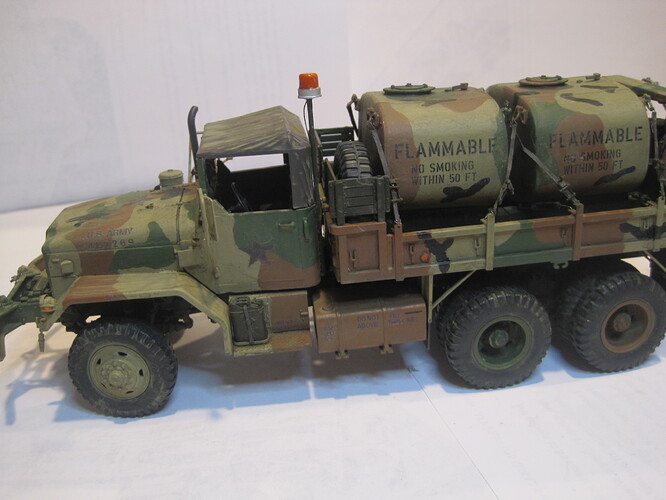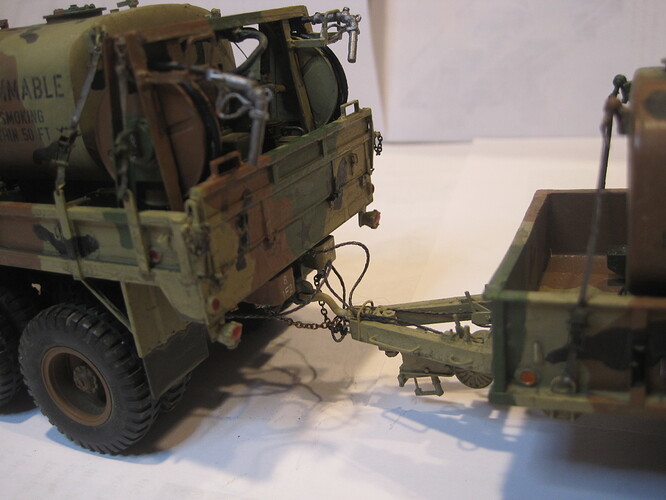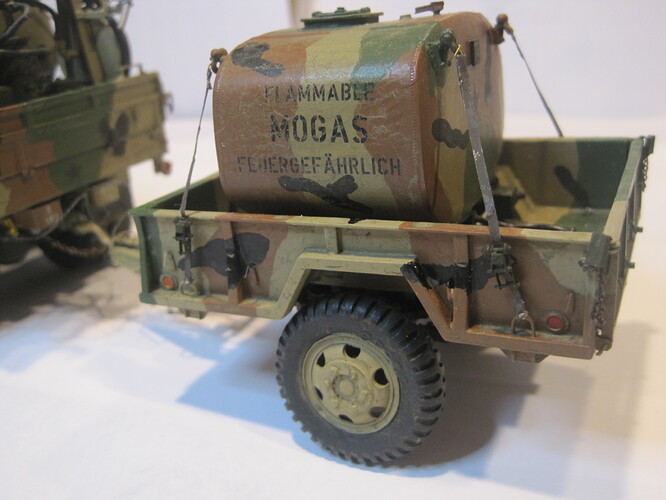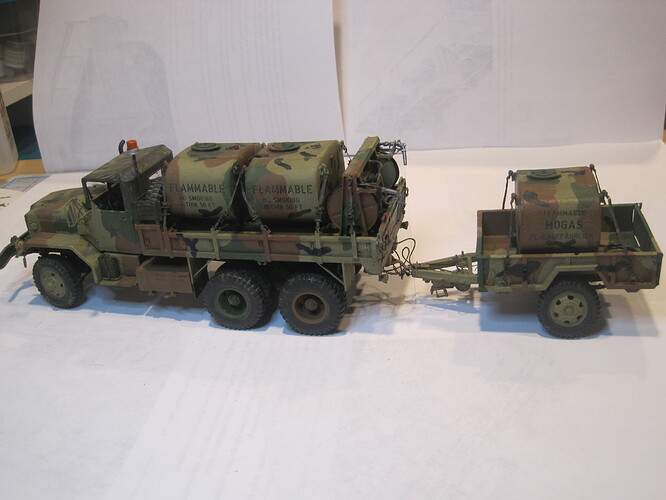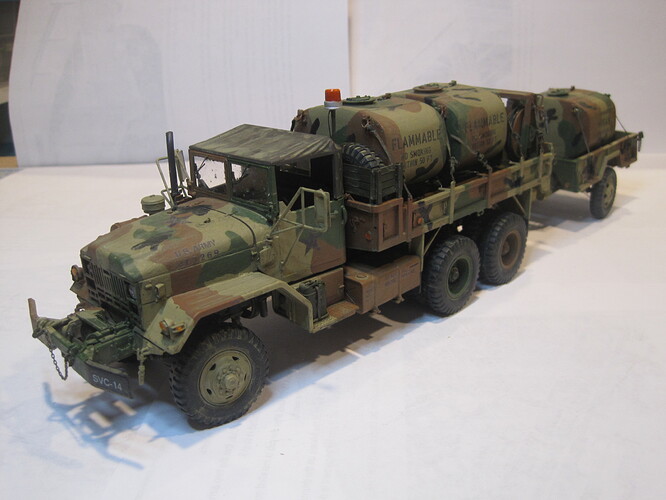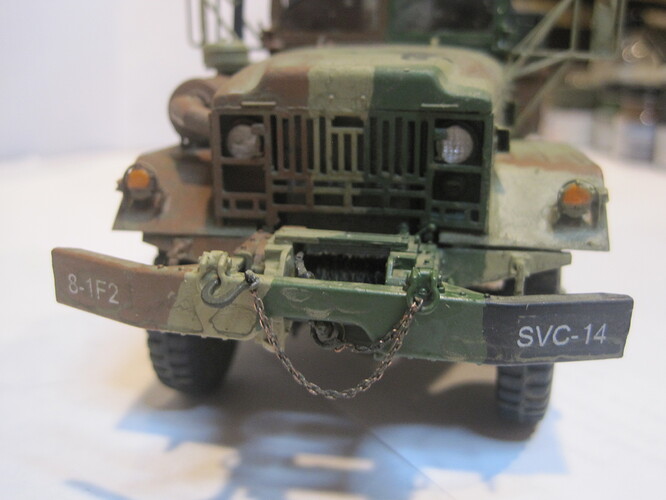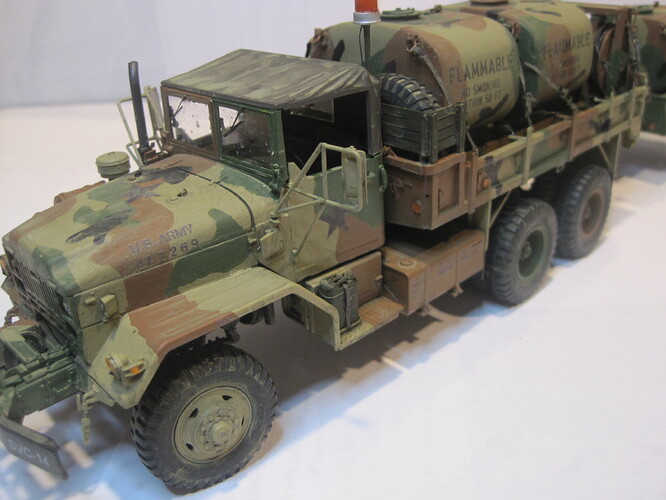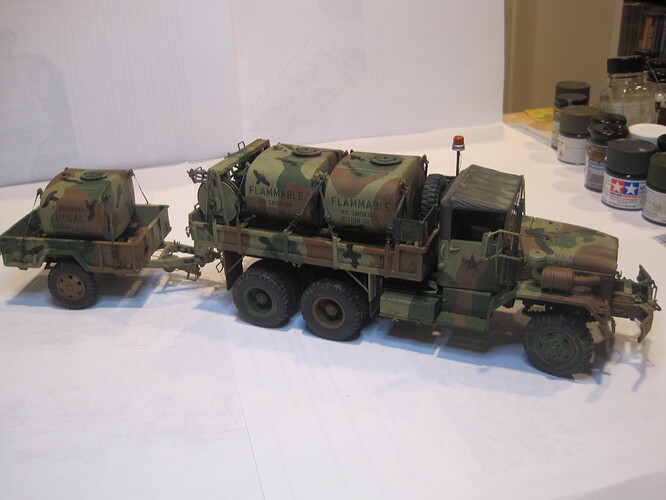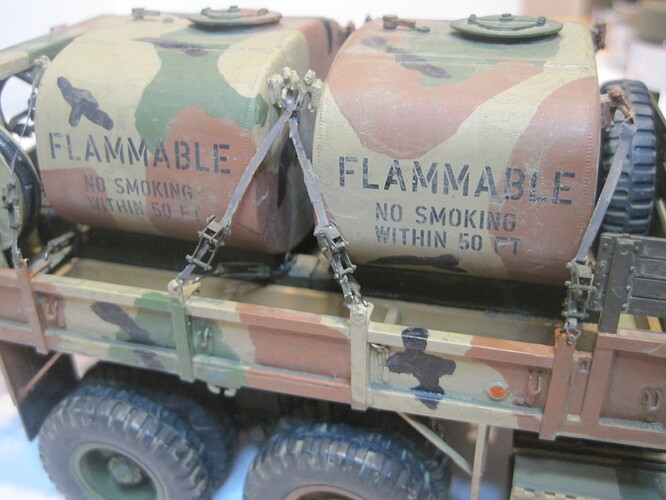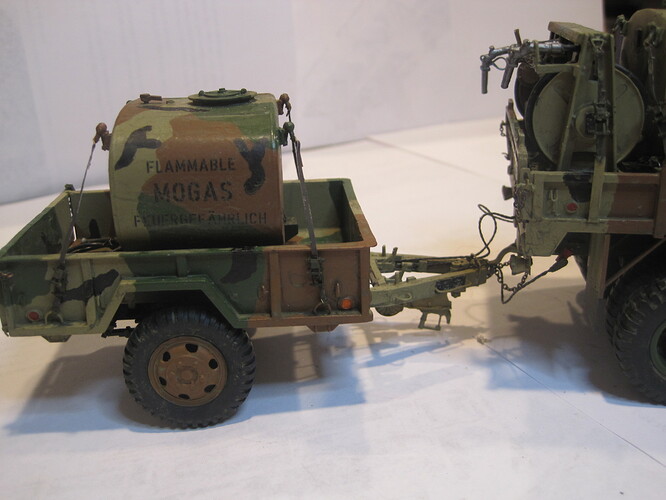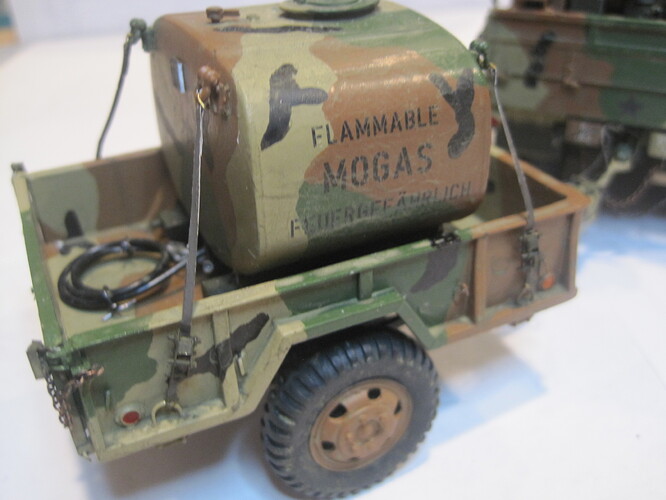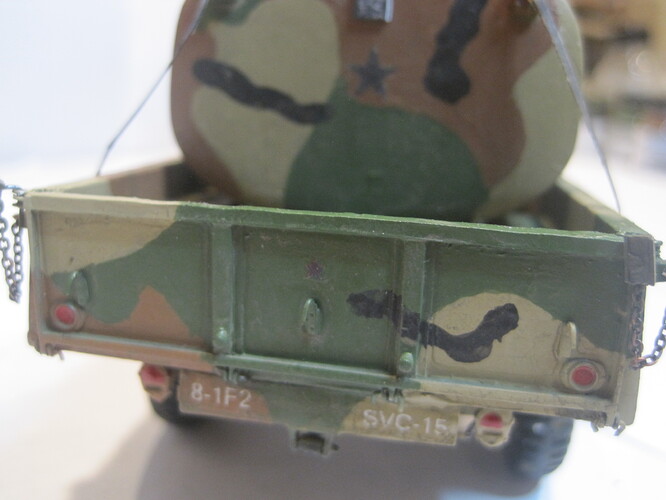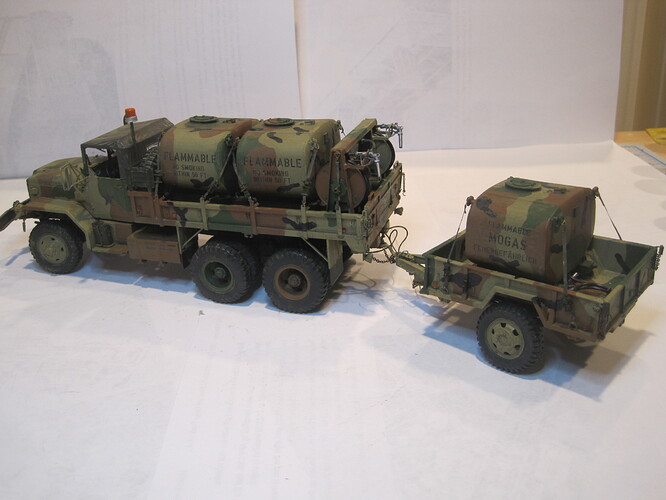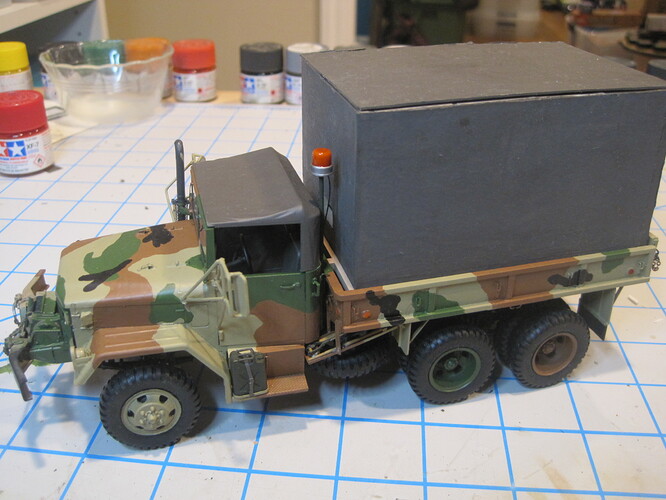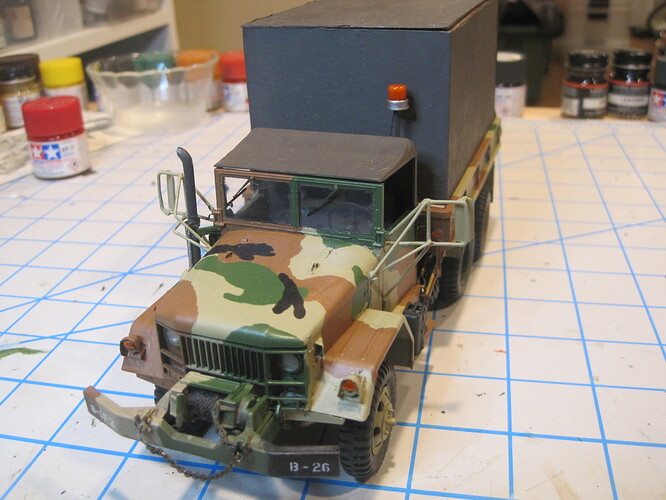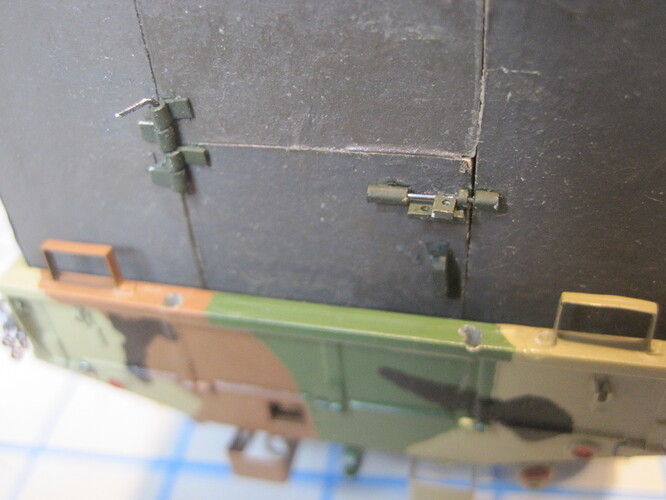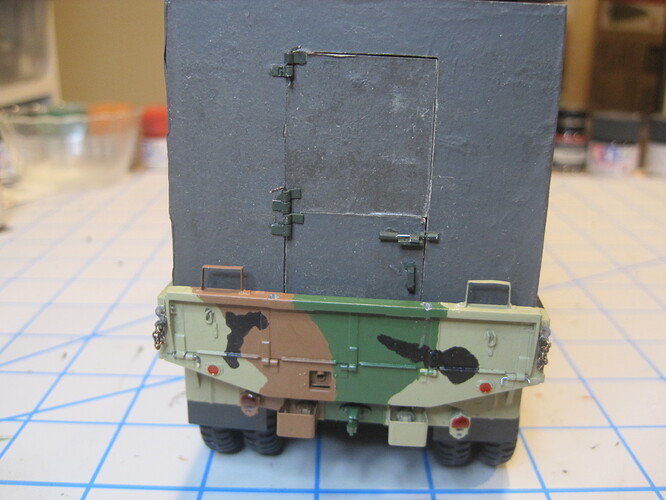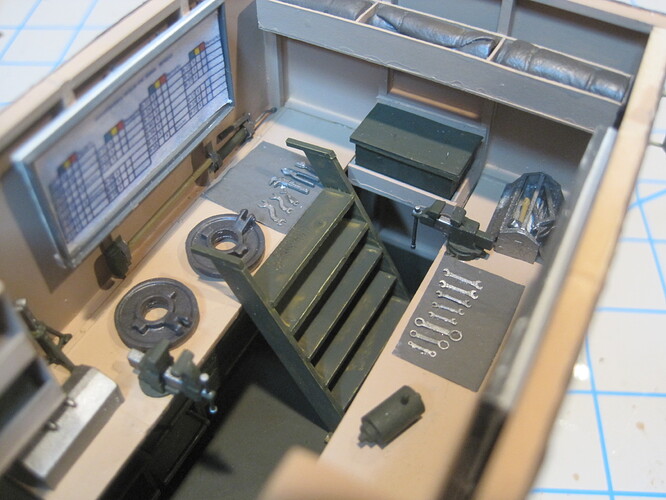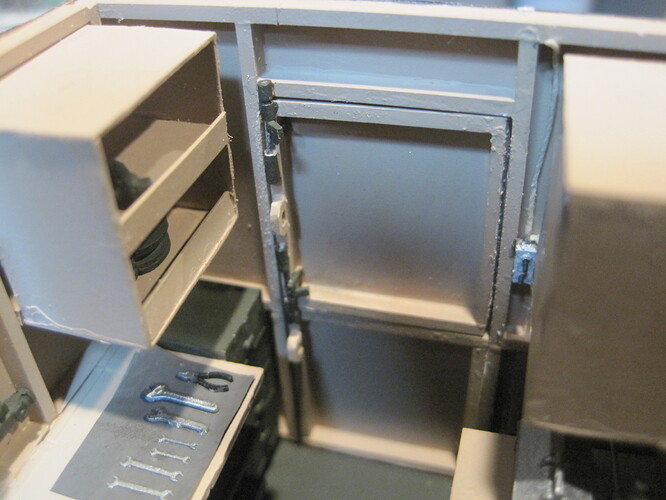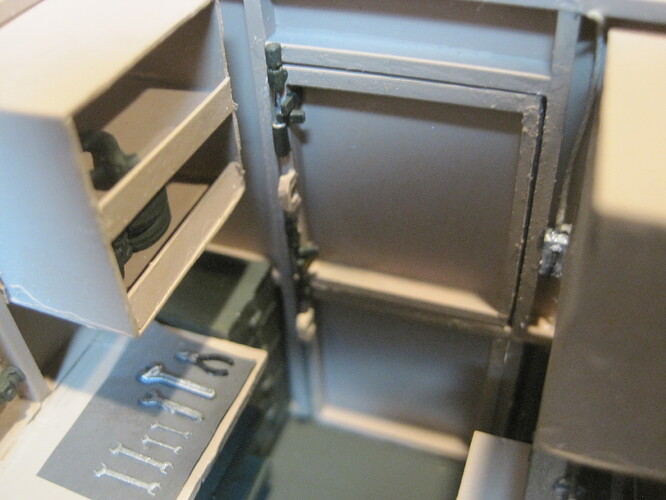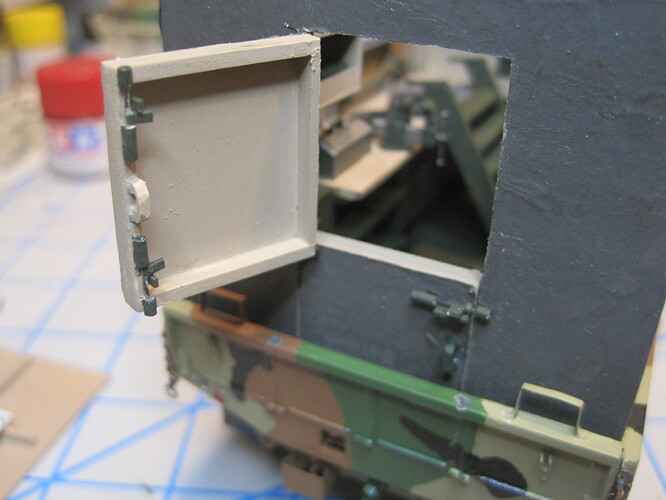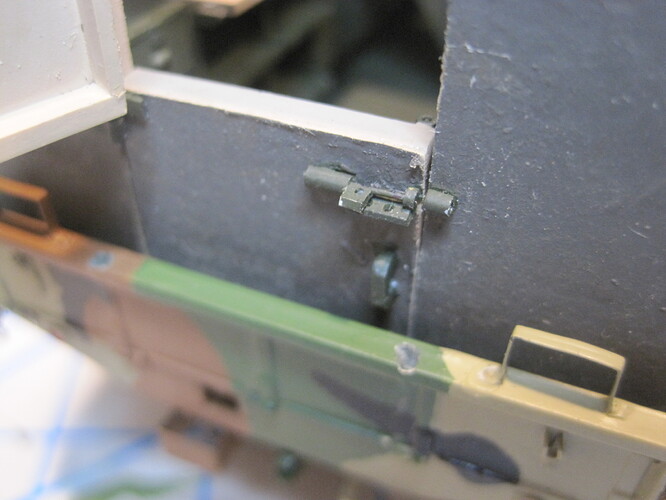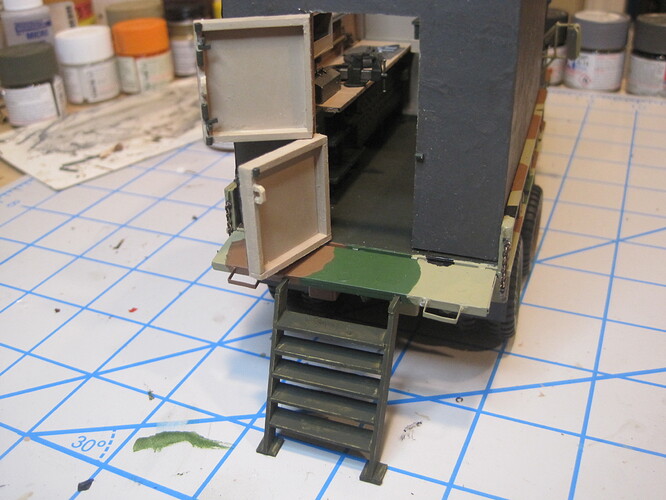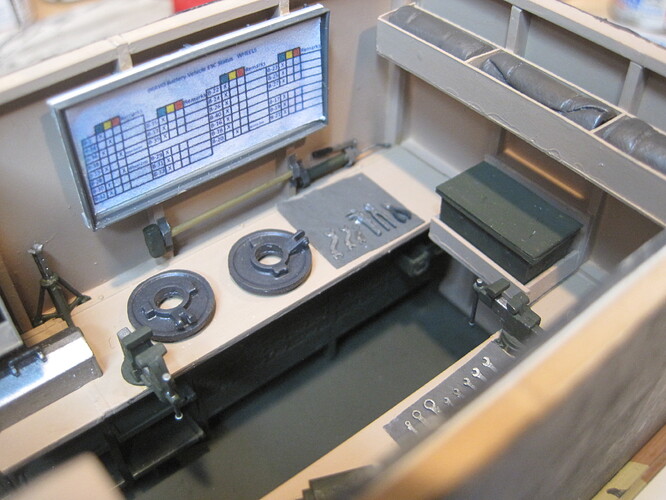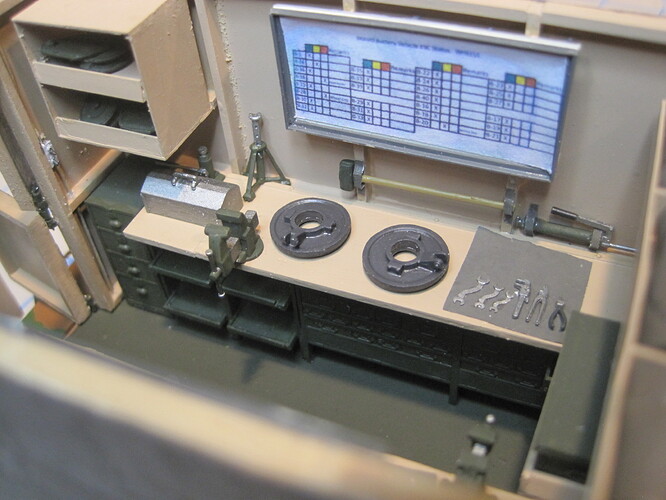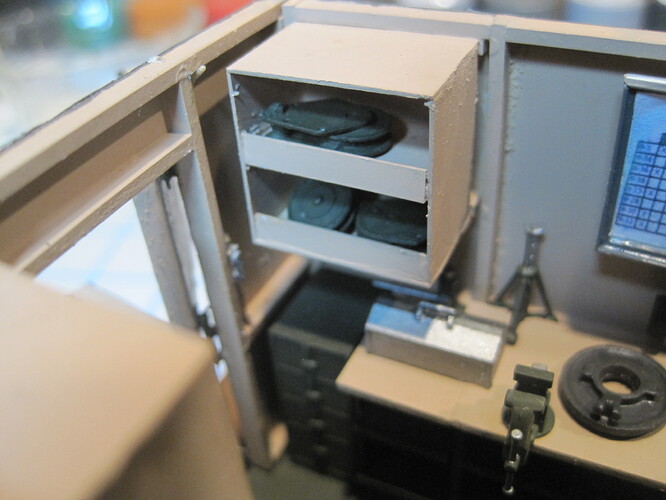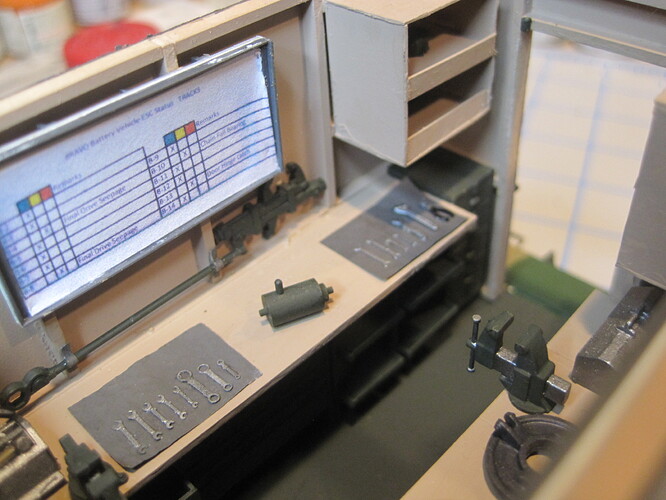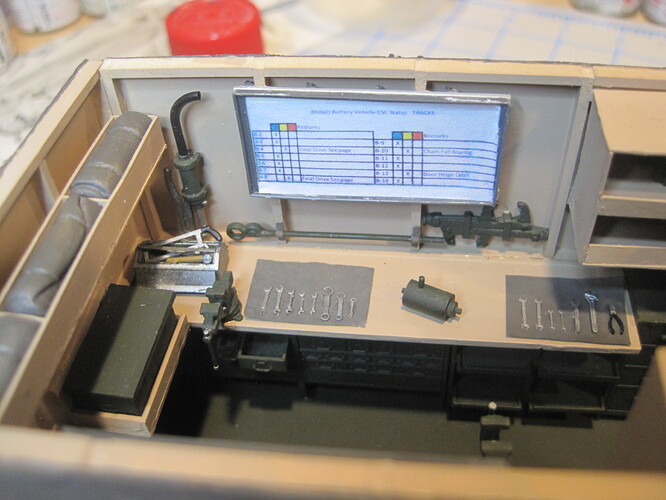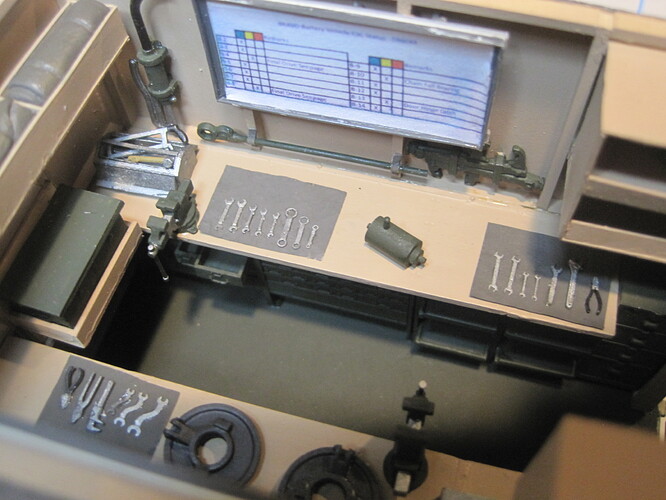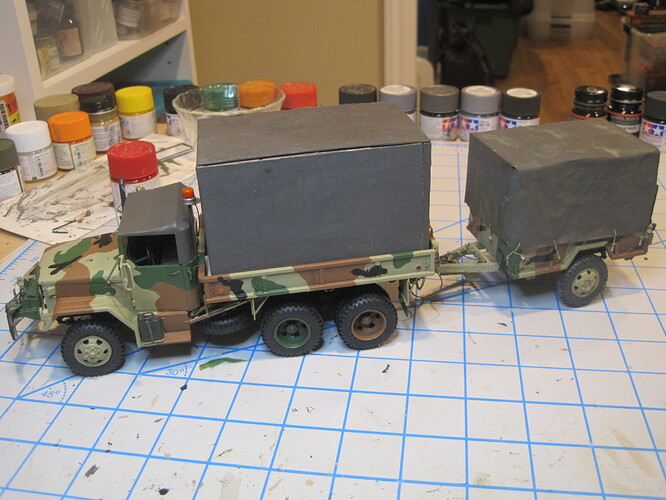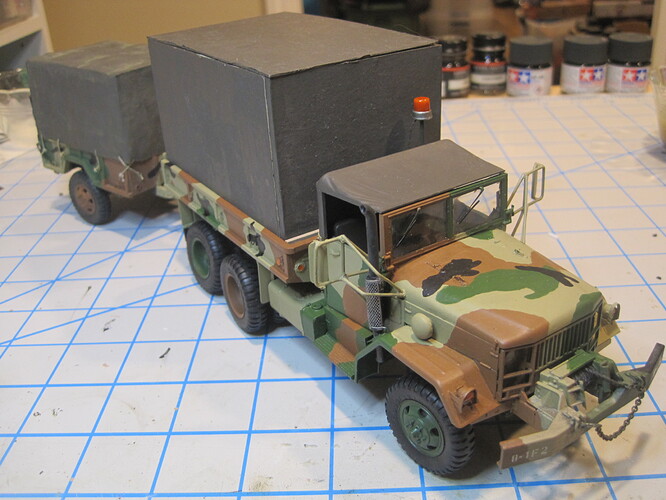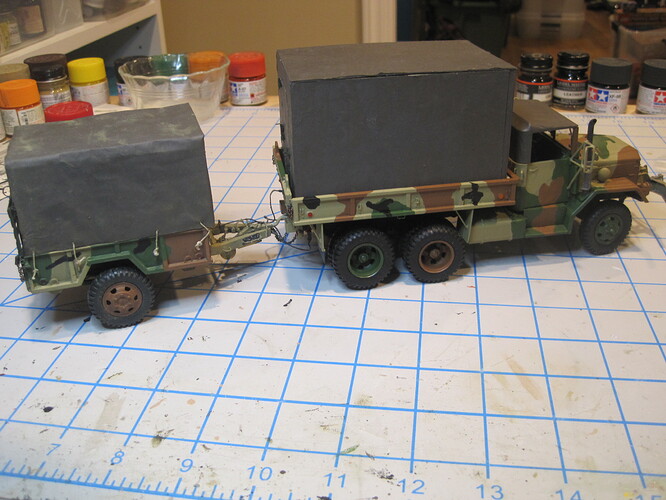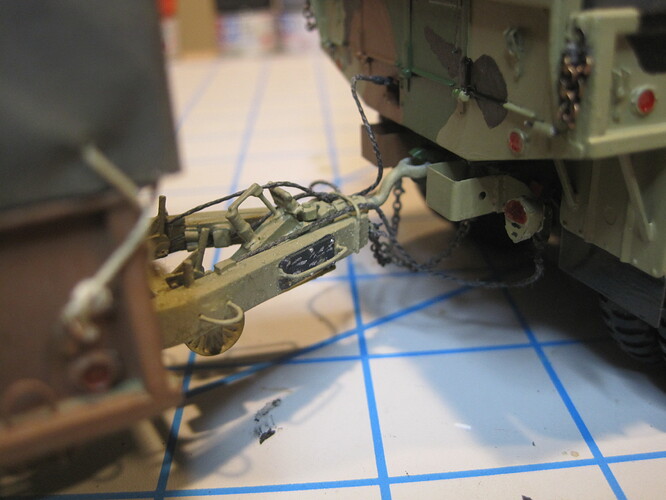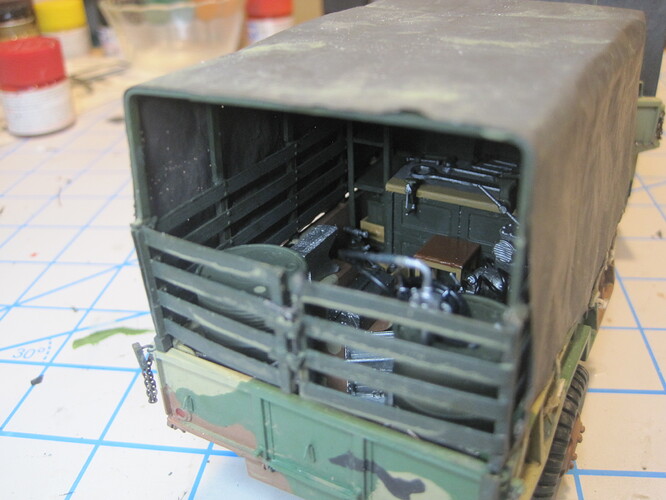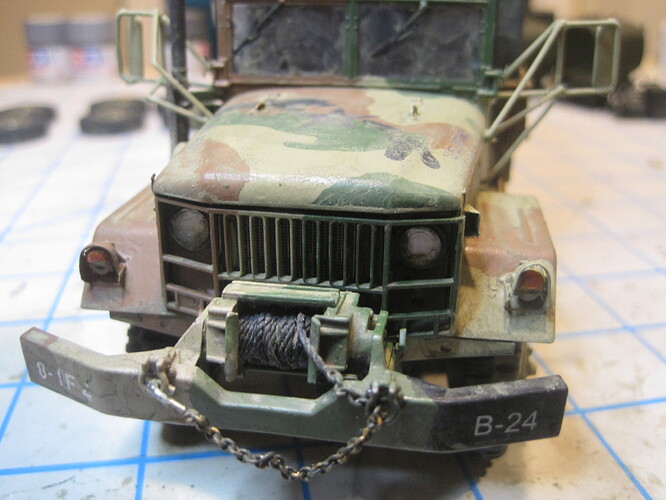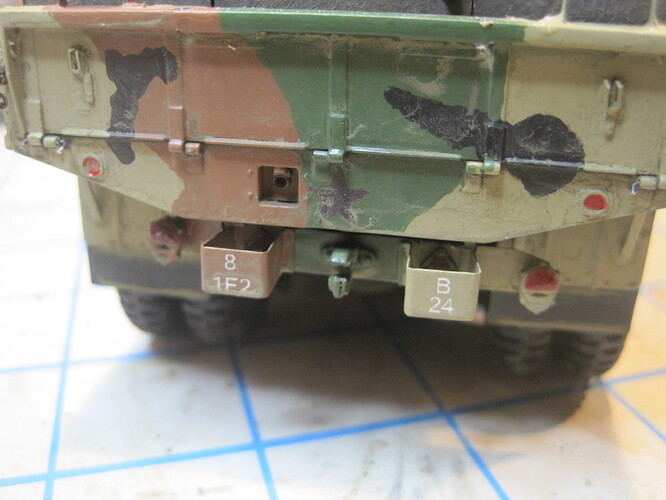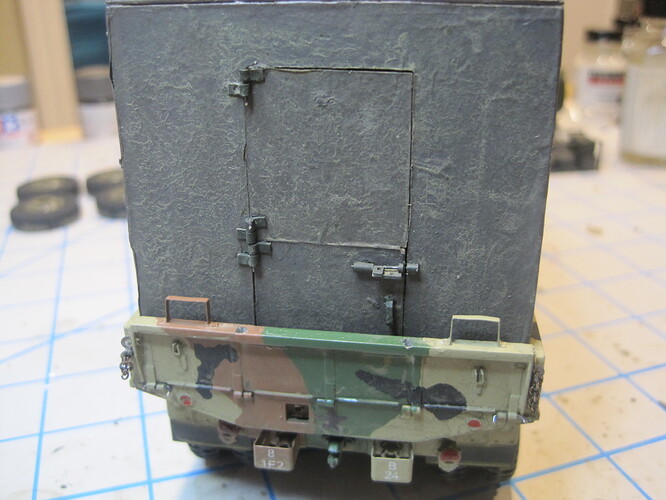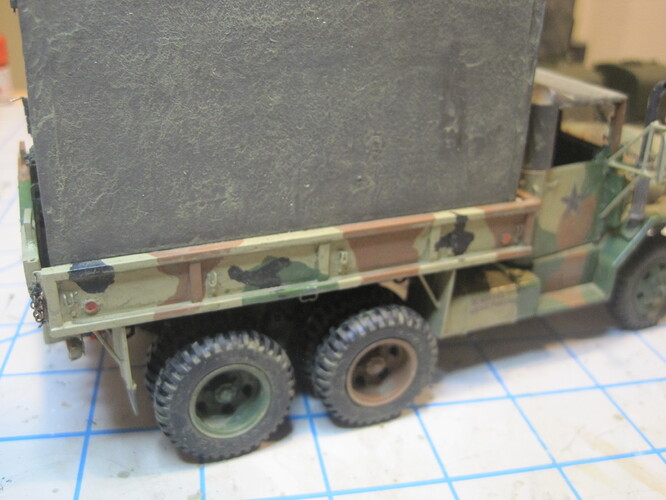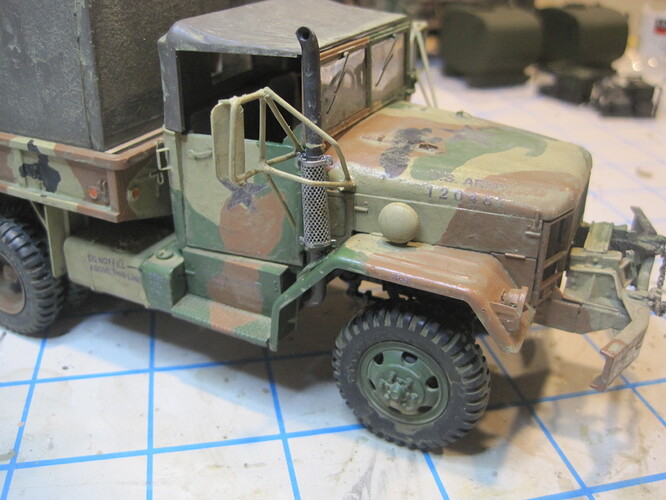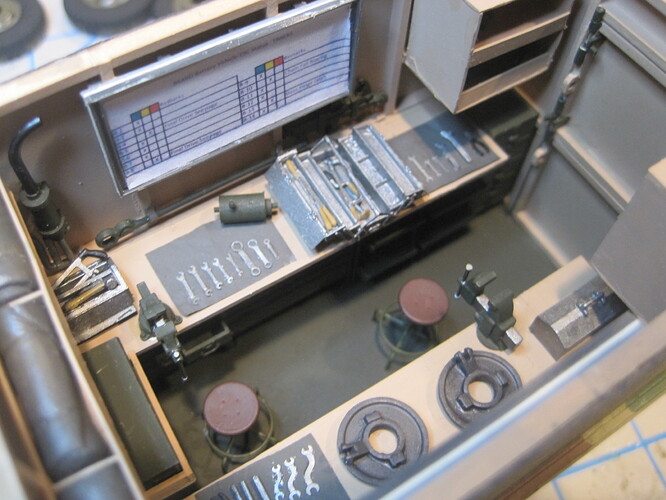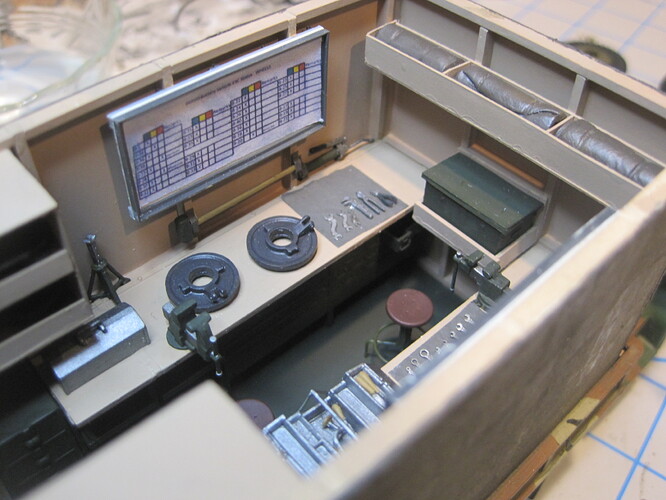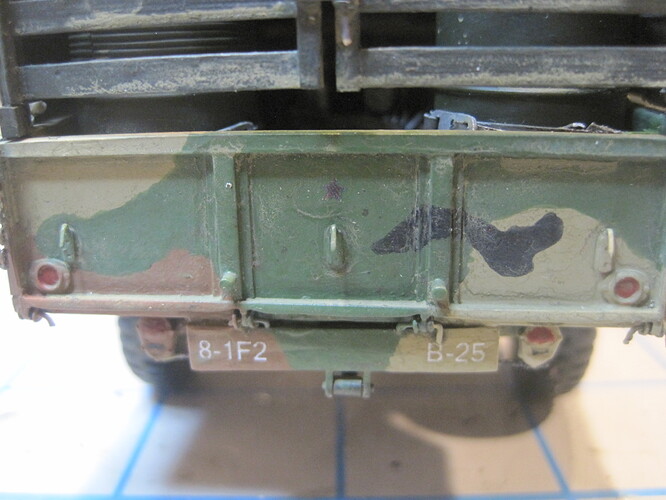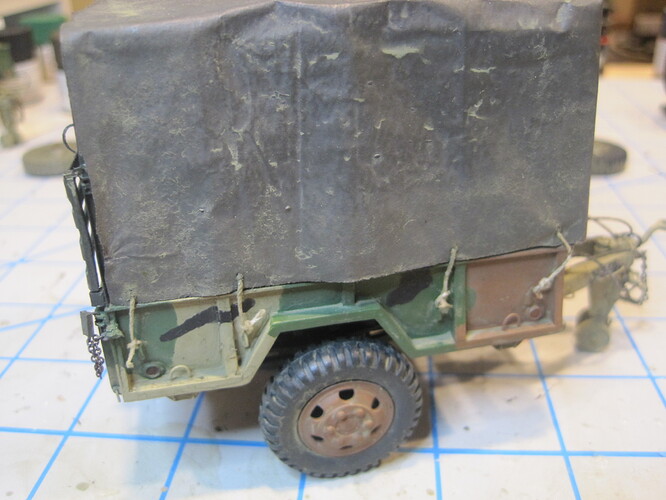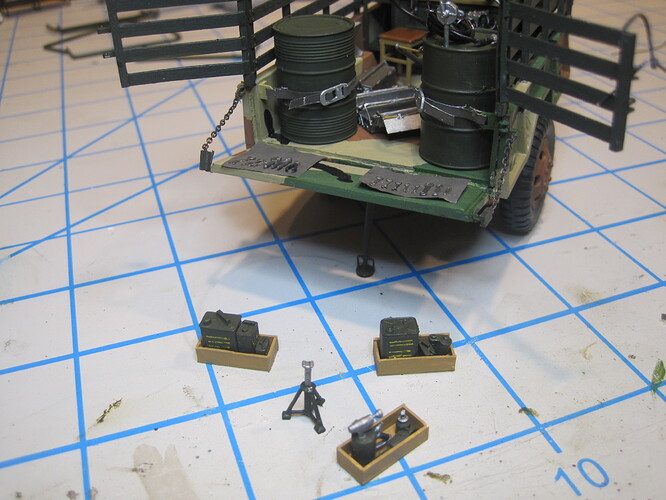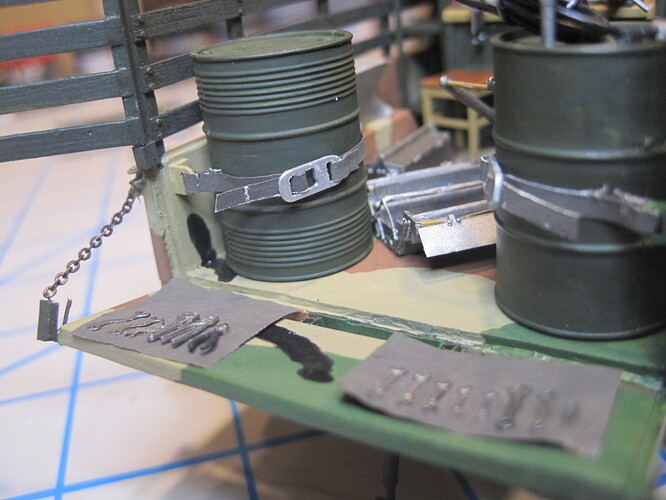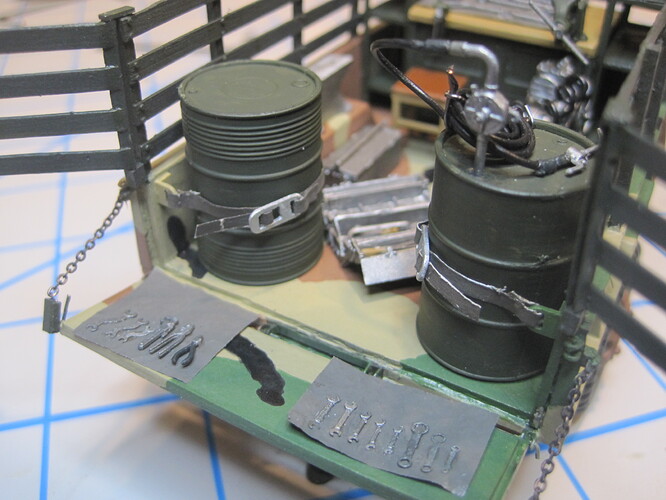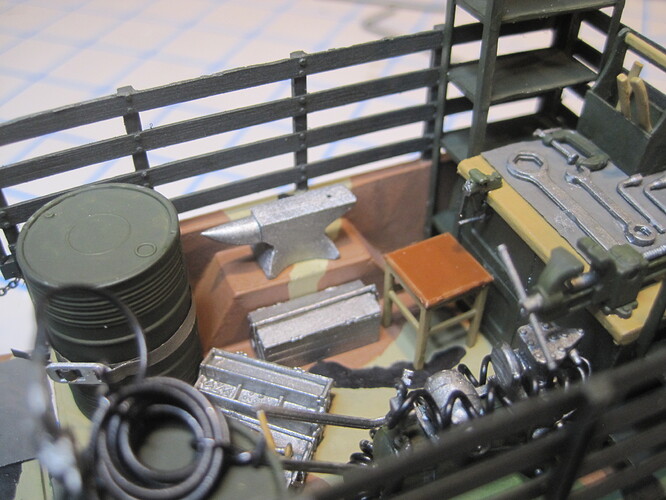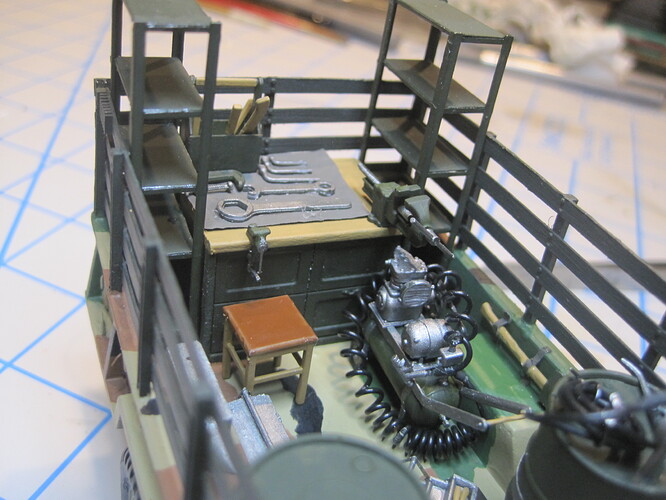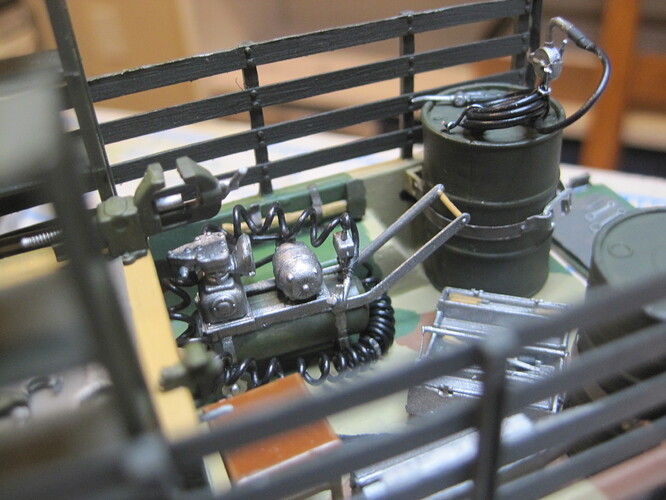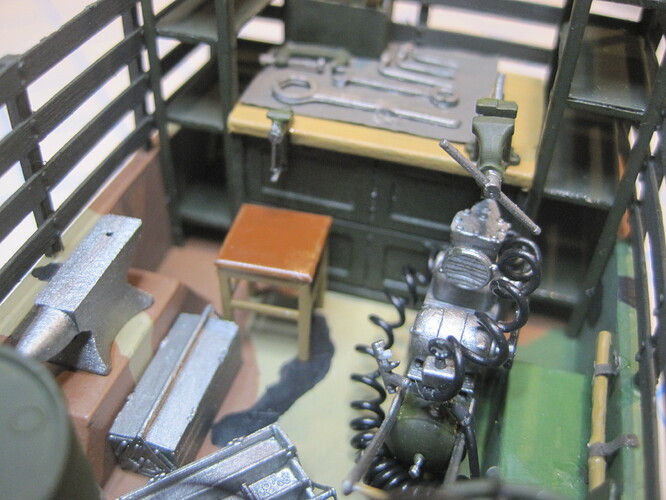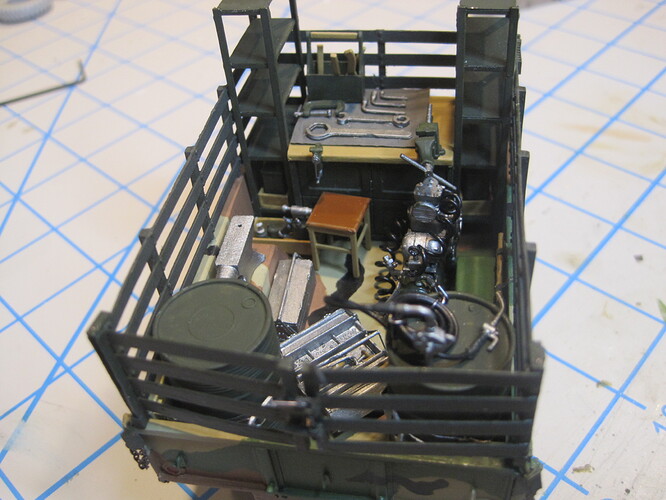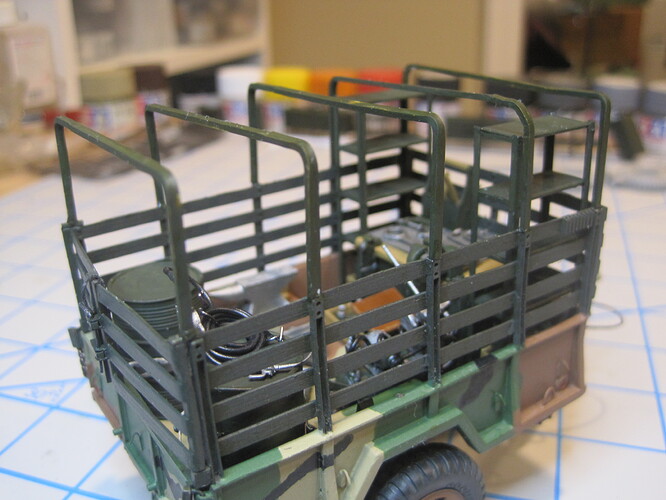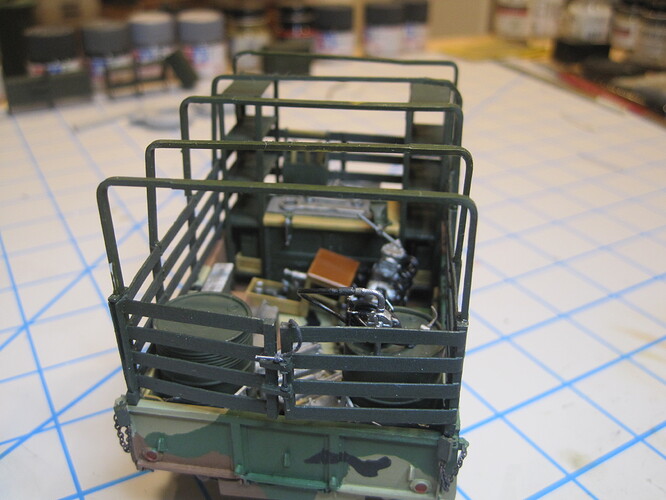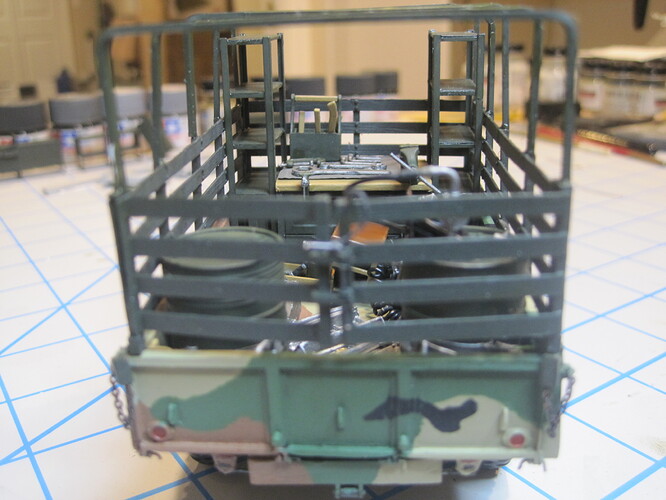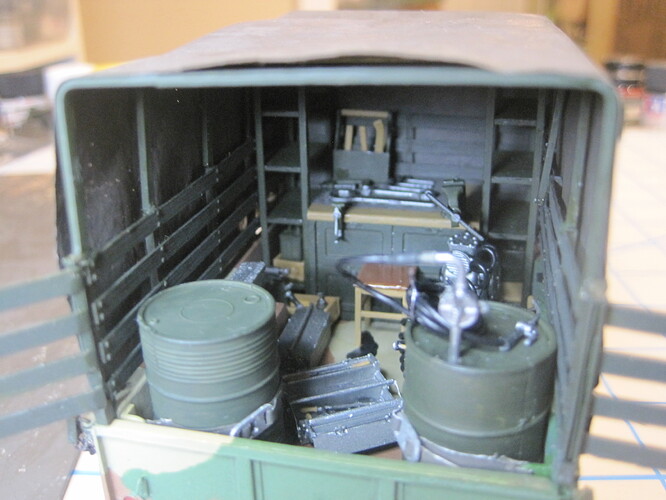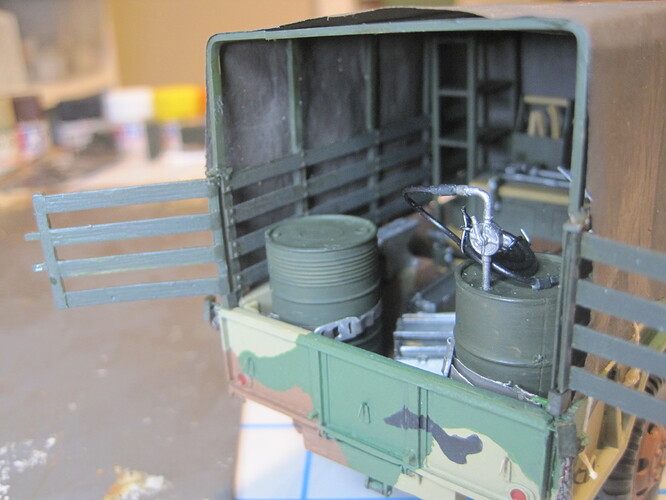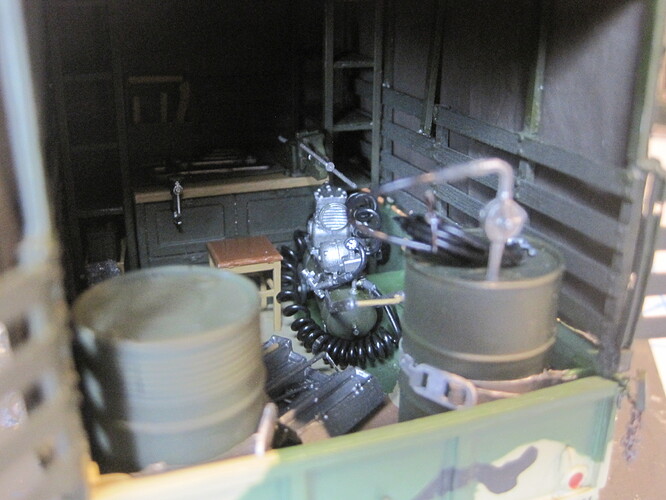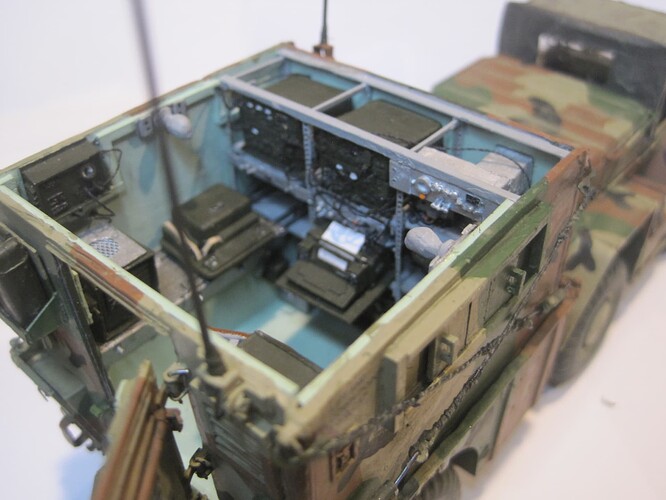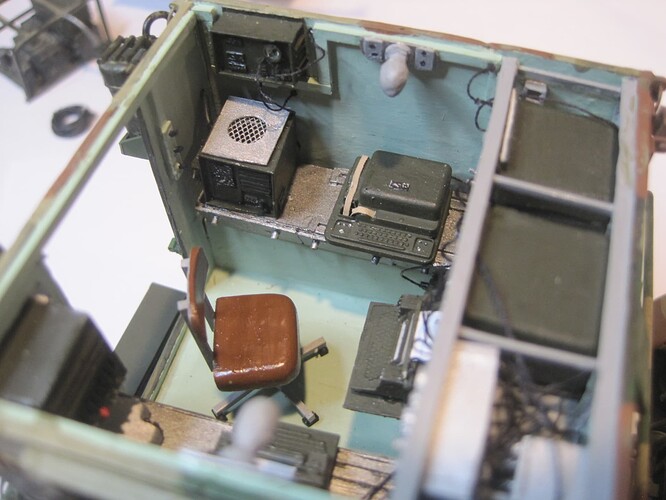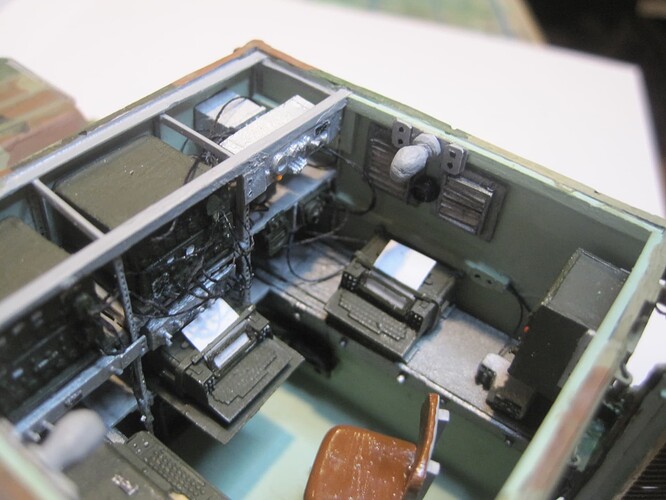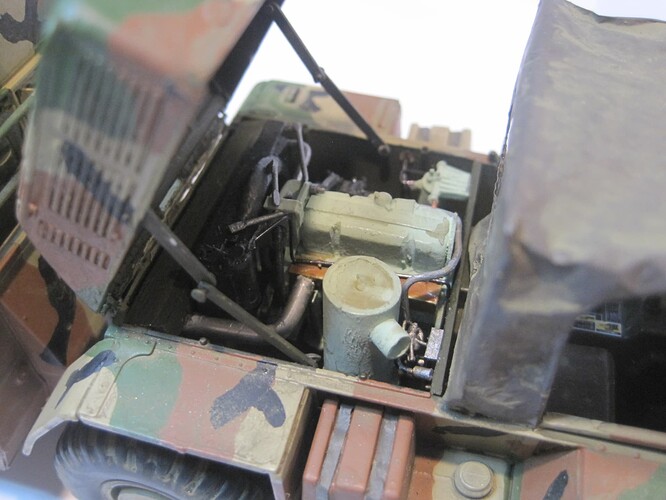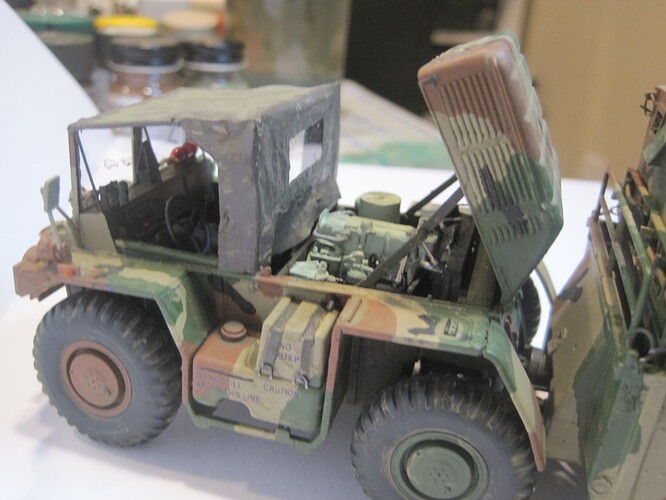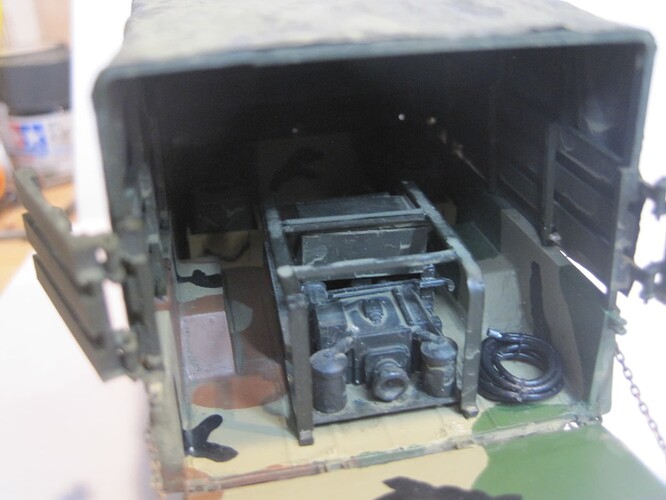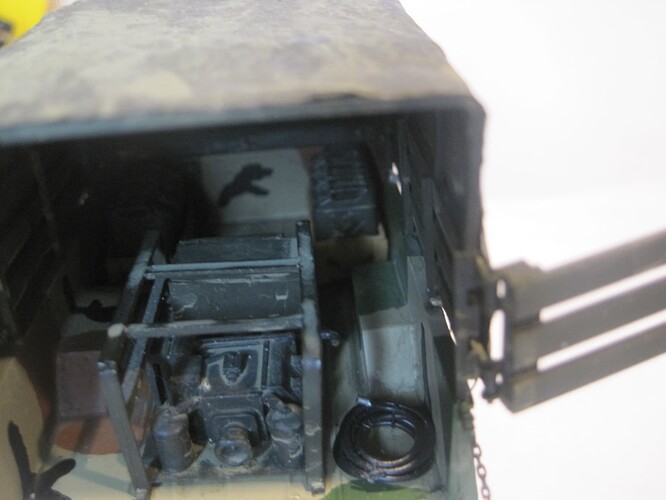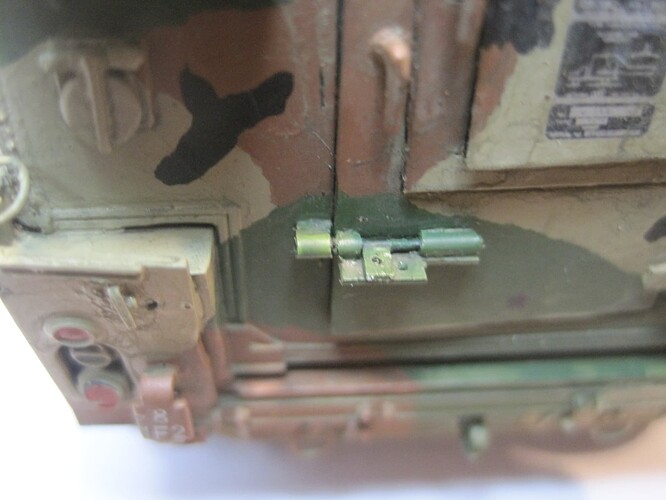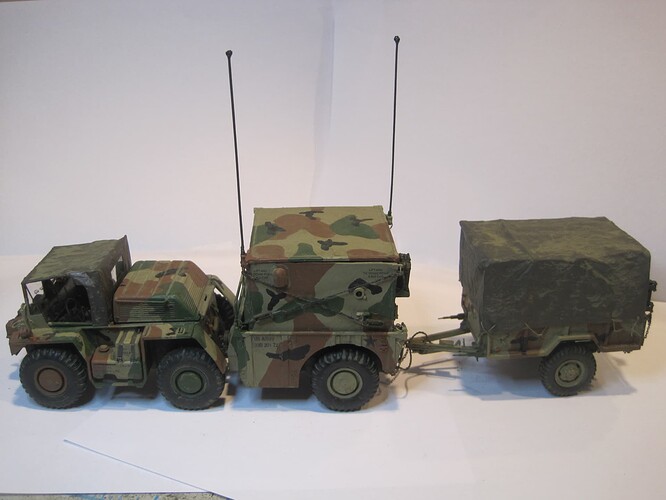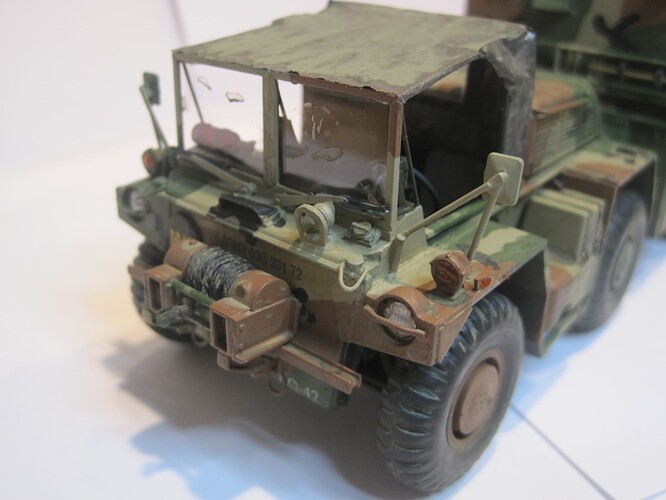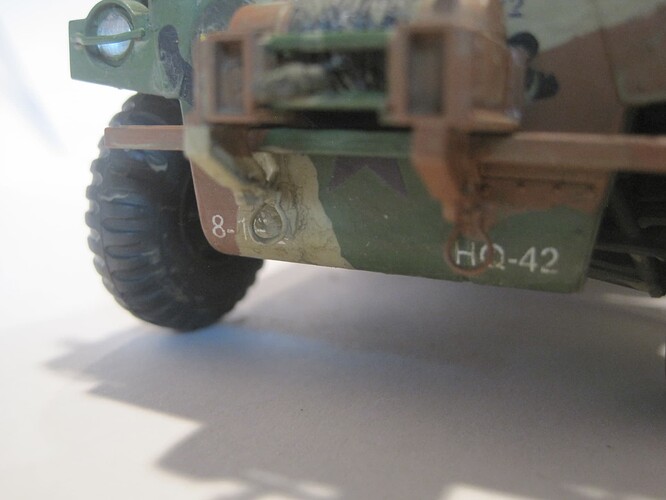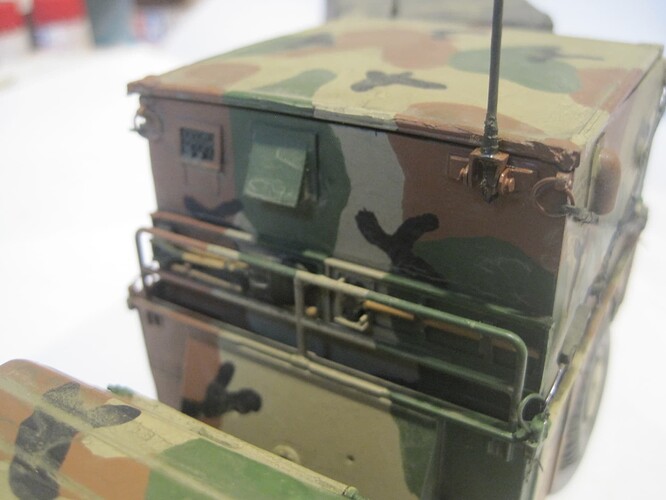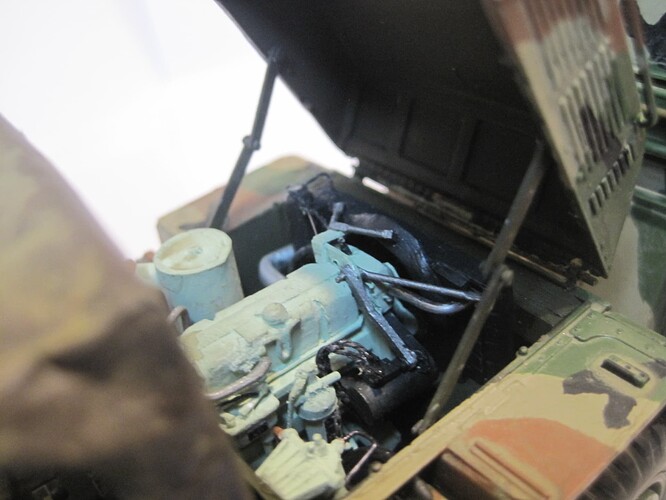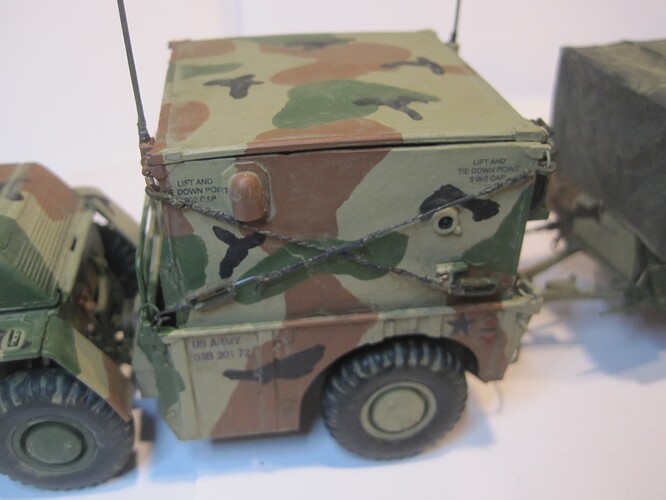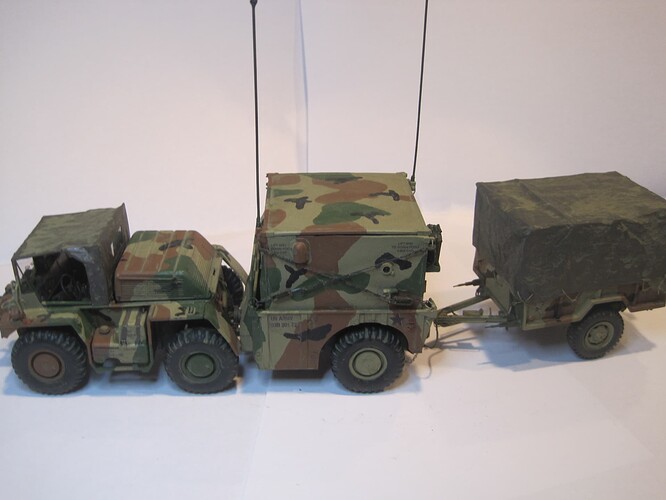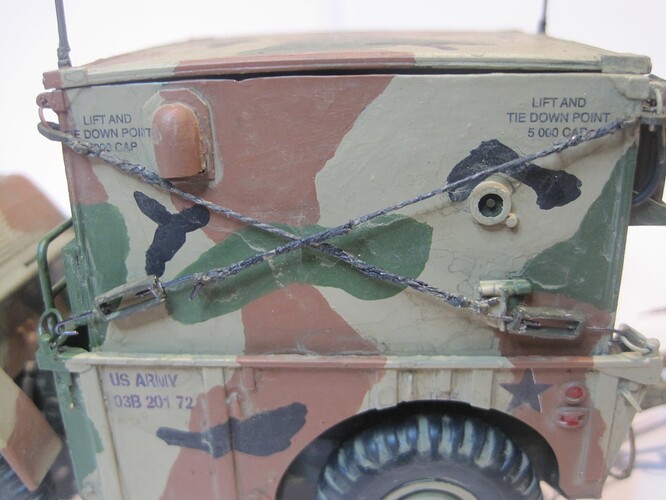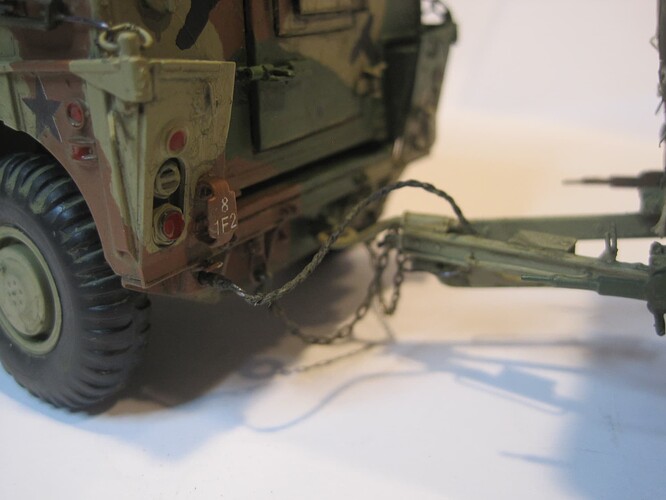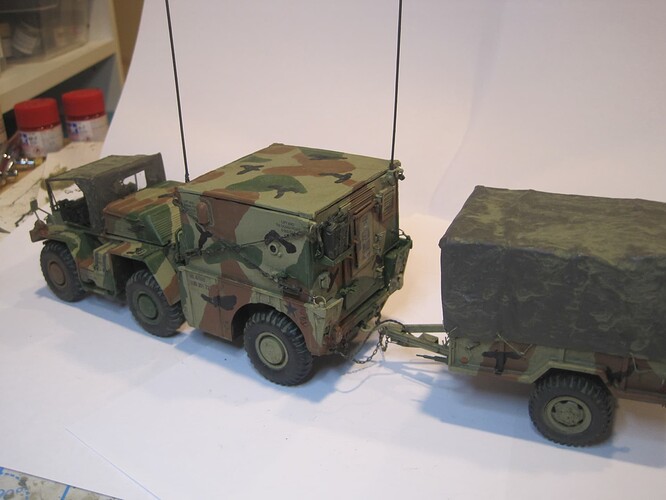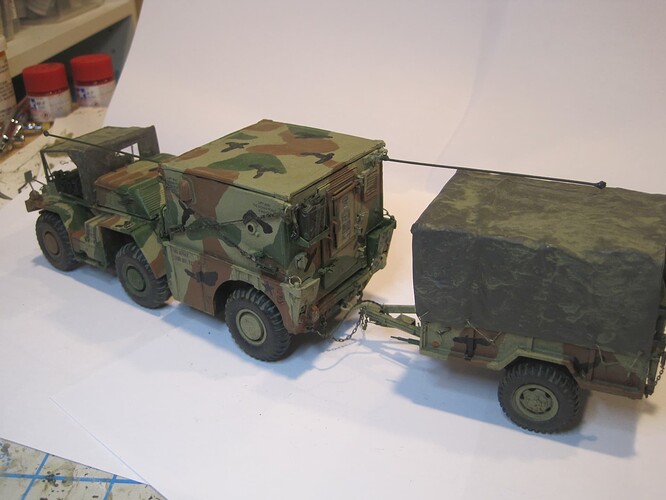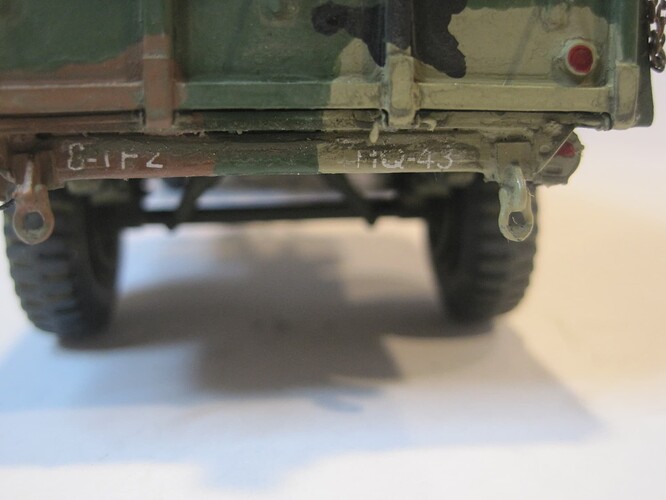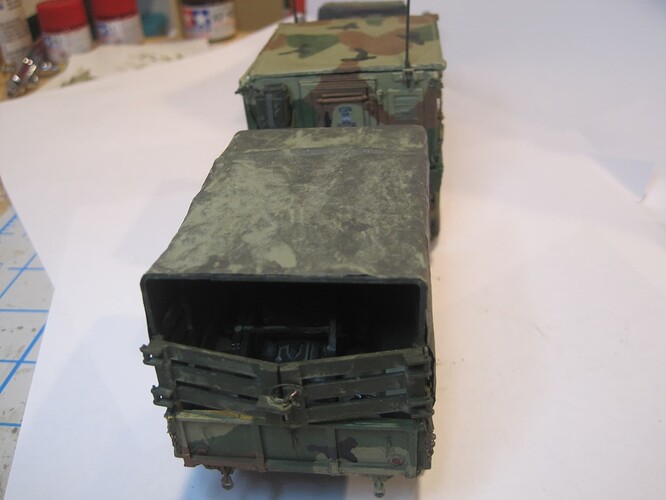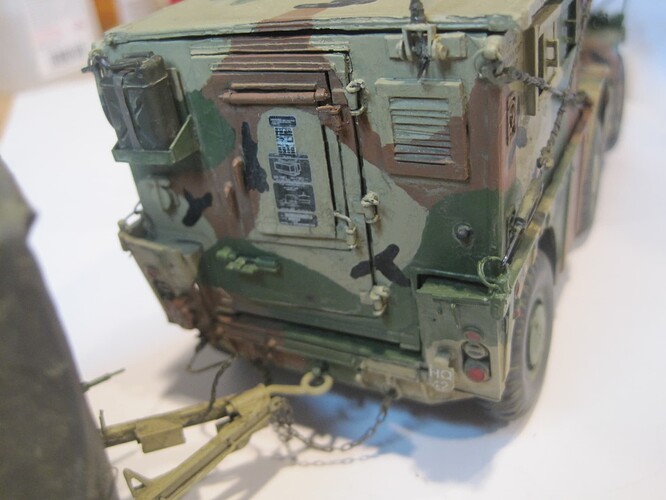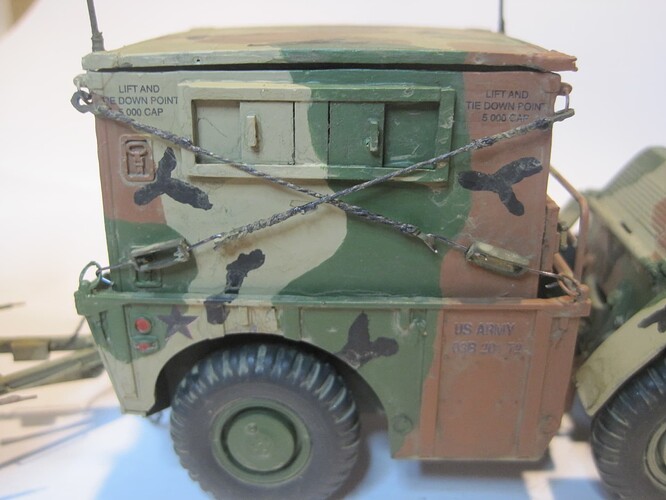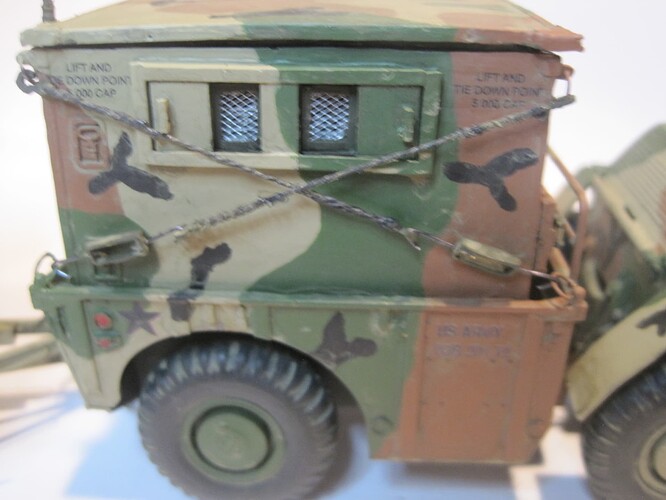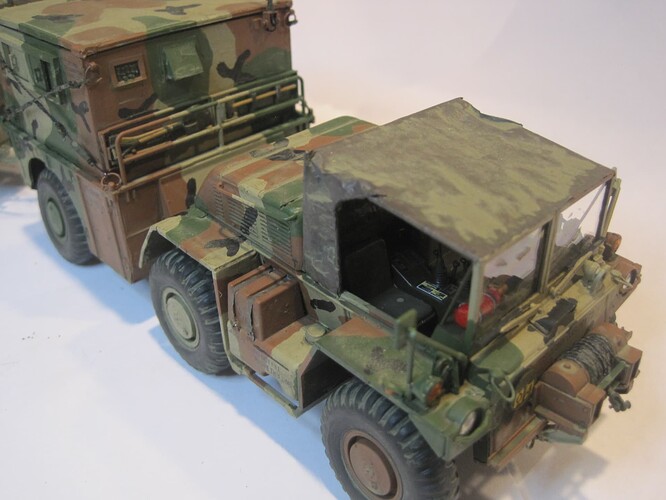Glad to send you a copy of both the templates and the documents representing the story behind how the program came about!
Missed this one until yesterday, started reading, finished today… absolutely fantasti building blog! Such extra background information, really good! like reading a (good!) history book. And your builds are superb!1
Did you scratchbuild all the extra’s like ammunition, in boxes, on pallets, etc? Really very very impressed… would love to see this in one big diorama…
Thanks so much. My current plan was to build a series of small (about 18 inch x 18 inch) scenes, each on with about 2-3 vehicles, which could either be displayed separately or grouped together to form one large display. But since my initial concept, I’ve decided on adding several more kits, so I may have to rethink my display options.
The problem of course is once you build all this stuff, where and how do you display it!!
The details are a “mixed bag” of after market items and scratch build. For example, all the pallets of 155mm ammo are from the AVF set which includes the projectiles, decals, pallets for the projectiles as well as powder canisters. But no dunnage for the canisters, so that’s scratch built.
Glad you enjoy it. Make sure you check out my M35 Maintenance Truck build. That’s the next one in the series.
Tom
Great idea, making all small dio’s that can be arranged into one big one!
And I will be following this topic from now on, want to see that next build as well. I am trying to find that AVF set, would you have a link or set nr?
Edit, found it 
And here is the latest edition to the collection, an M54 5 Ton tanker, equipped with two 600 Gallon Diesel pods and a pump unit, towing an M105 trailer with an additional 600 Gallon pod of MOGAS.
As stated in an earlier post, the TO&E for my unit called for a Fuel Section consisting of two M-54s each equipped with two 600 Gallon fuel pods, and each one towing an M105 trailer also equipped with a 600 Gallon Pod. One of the two vehicles in the section was equipped with a winch, so I have built SVC-14 with a winch. I wasn’t sure when I started whether both of the trailer mounted pods were for MOGAS or not, and further research (while not definitive for sure) but based on the information I found in US Army FM 101-10-1 Volume 2 (STAFF OFFICERS’ FIELD MANUAL ORGANIZATIONAL, TECHNICAL, AND LOGISTICAL DATA PLANNING FACTORS) has led me to conclude that while it may have gone either way, the PROBABLE answer is that only one of the trailer mounted pods was MOGAS.
My reasoning is that using the planning factors (like a good G-4) I was able to calculate the total requirements of one FA Battalion equipped with 155mm Howitzers for 1 day of operation for all categories of equipment using the “European usage profile”. The TO&E cited was certainly NOT an exact match, specifically it had NO consumption factor for MOGAS for Wheeled Vehicles, almost certainly reflecting the replacement of our M151 fleet which did use MOGAS with Humvees which do not:
The calculations reveal that ONE Battalion operating in the field requires the following quantities of fuel PER DAY:
MOGAS: 629 Gallons
Diesel:7790 Gallons.
If you reduce the Diesel consumption by 20 percent based on shifting the number of jeeps out of the Diesel and into the MOGAS column, and adjusted consumption looks more like:
2360 Gallons for MOGAS and 6059 Gallons for Diesel.
That leads me to conclude that the Battalion would use three times as much Diesel as MOGAS.
That would mean THREE pods of Diesel for every one of MOGAS.
So while I can see an argument for either situation the larger requirement for Diesel PROBABLY meant only one of the six pods held MOGAS. Either way I enjoyed the challenge of thinking through the problem!
So with all that Loggie junk out of the way, here are the finished shots:
Bravo! That came out as nicely as all the rest of your MASSTER collection!
Looking over this post I realized that while I did create a separate build log for the B Battery Maintenance Truck, I didn’t include the finished vehicle photos in this posting which I had intended to include all of the vehicles from the Battalion which I’ve built. So I’m re-posting all the completed photos of B-24 and B-25 which are an M35 2 1/2 Ton truck with a plywood shelter on the back for the Battery Maintenance Section and an M105 1 1/2 Ton Trailer.
The level and quality of your scratch built details is excellent.
Please remove these pictures and this topic… so we, mere mortals won’t be so dissapointed about our efforts…
Absolutely fantastic!
I’ve said it before and I’ll say it again (or at least I think I have): magisterial. From the explanation and organisational details let alone the sheer construction virtuosity - this has been a seminal work. As a fan of the MASSTER scheme (not least as I remember it) I would say that perhaps, but this truly has been a modelling voyage, of both learning and discovery.
Thanks for all your efforts Tom.
Thanks Rick, Bert and Brian!!! And I think you’ll be interested in my next vehicle in the series. My plan has been to try and represent at least of one vehicle type covering all the different vehicles assigned to the unit, with a couple of exceptions. In Service Battery we had one M-88 and I’ve already built one of those, but I decided to make it in 3 Color NATO as part of another unit to which I was assigned, 4th Bn 20th FA, so I won’t be doing that. And also in SVC at the moment I am not planning to build an M816 5 Ton Wrecker.
In HHB the Radar Section we had three unique vehicles, an M109 shop van, an AN/MPQ-4 Radar and a 10KW trailer mounted generator which I am also not planning to build. And since the single M792 Gama Goat Ambulance is quite similar to a regular Gama Goat (and wasn’t painted in MASSTER anyway) I am not planning to build that either.
But I do need to add a vehicle from HHB, so I have decided that I WILL be building an M561 Gama Goat with an S-250 shelter to represent one of the RTT rigs we had. And as Rick had suggested earlier, I’m bringing a bit of 21st tech into the process. I got together with my son, and we created some CAD models for most of the major components which comprise an AN/GRC 122 RTT system, and created some models using a 3-D laser printer. It took some time, but with access to the proper equipment at a local shop, we were able to make some very serviceable parts.
Rick, I know you were interested as well and I have some extras, so once I start my build log and post some photos, let me know if you’re interested in doing one as well and I can send you any of the extras you want.
I’ve started the build log for the RTT Gama Goat as another thread and you can follow the progress of that build there. But since this thread is more about the entire Battalion as a whole, and I’ve already described the composition of the three Firing Batteries as well as Service Battery, I’ll take this opportunity to explain the composition of the “Headquarters and Headquarters Battery”, of a Self Propelled 155mm unit in a Mechanized Division as it was comprised by the TO&E of the early to mid 1970’s.
So the first thing is why is it Headquarters AND Headquarters Battery?? The reason is that the battery is divided into two separate major parts. The first is the Battalion Headquarters.
This small piece consists of only 12 personnel, but it is a significant and important piece. There are 11 officers which include the Battalion Commander, Battalion Executive Officer (XO), and the battalion staff officers which are the S-1 (Personnel), S-2 (Intelligence), S-3 (Operations and Plans), Battalion Motor Officer (you may recall that in this unit, the SVC Battery Commander, since he has all the Supply, Ammo and Maintenance assets serves as the S-4), the Battalion Commo Officer, and four Liaison Officers. And finally the Battalion Command Sergeant Major is part of Bn HQ.
The vehicles that we had associated with this group were as follows:
The Battalion Commander rode in HQ-6, which was an M151 equipped with an AN/VRC-49 which is a fancy way of saying he had two AN/VRC-46 radio transmitter/receivers. And behind this vehicle was HQ-66, an M416 1/4 ton Trailer. And the BN CSM always rode in HQ-6 with the Commander.
The Battalion XO rode in HQ-5, which was an M151 but he only had an AN/VRC-47, which was one Receiver/Transmitter and one single receiver only. This vehicle also had an M416 trailer which was HQ-65.
The Battalion S-3 rode in HQ-3 which was an M151, and he also had a two radio AN/VRC-49 set up like the Bn CO. This vehicle also had an M416 with the bumper number HQ-33.
The Battalion S-2 rode in HQ-2, again an M151, but he only had a single AN/VRC-46 and no trailer.
The Battalion Motor Officer rode in HQ-4, and like the S-2 this was an M151 with a single AN/VRC-46 and no trailer.
And what about the Battalion S-1? Well his vehicle was actually HQ-11. And again this was an M151 with a single AN/VRC-46 and no trailer. Why not HQ-1? Because that number belonged to the BATTERY Commander.
The Battalion Commo Officer rode in HQ-7 which again was an M151 with a single AN/VRC-46 and no trailer.
The remaining 4 personnel in the Battalion HQ were Liaison Officers.
The mission for this battalion was Direct Support to one of the three Combat Brigades in the Division, so one of these Liaison officers would go to the Command Post of that Brigade to provide the coordination at that level, and the other three would locate with each of the three Maneuver Battalions in that Brigade. (And each of the three letter Firing Batteries would normally provide fire support to one of those battalions.)
To do this there were 4 M577 tracks. These were each equipped with the AN/VRC-49 or two radios. Generally one was kept on the supported unit’s Command Frequency and the other on our Battalion Command Frequency. These for Tracks were numbered, HQ-46, HQ-47, HQ-48 and HQ-49.
So one quick word about the state of the US Army in Germany in 1972-1975 as the Vietnam war was winding down. While we OCCASIONALLY had a Captain as Commo Officer, and MAYBE another Captain as the BMO, we almost NEVER had any, much less FOUR Captains to serve as Liaison Officers. This matched the problem we had with Lieutenants. Each Battery was SUPPOSED to have three Forward Observers assigned, so that one could go to each Maneuver COMPANY that Battery was supporting. But we never had but one assigned.
And the problem was even worse than that.
Our Battalion was tasked with supporting the 2nd Brigade of the Division. And while the normal composition of a Brigade was three Battalions, the 2nd Brigade of the 8th ID at that time consisted of FIVE Battalions, three Infantry and two Armor. As crazy as it was trying to support all these units for training purposes when we were so short, I can’t even begin to imagine what it would have been like if we’d had to go to war. (If the Warsaw Pact had only known. But I guess they had their own problems!)
So that explains the “Headquarters” piece of HHB. I’ll talk about the Headquarters Battery in a later post.
That’s really nice. Only thing I think it needs is a few rolls of 100mph tape. Beautifully done!
Today I’ll explain the next piece of the HHB, which is the “Battery Headquarters”.
The “Battery Headquarters” consisted of 18 personnel including the Battery Commander, First Sergeant, the Battery Mess, Maintenance and Supply sections (like those in all the other Batteries), the Unit Clerk, and the Battery Commander’s Driver.
As I mentioned before, the Battery Commander’s vehicle was HQ-1, an M151 and as with all the other Battery Commanders, this vehicle had an AN/VRC-47 or one VRC-46 receiver/transmitter and a single receiver only. This allowed him to listen/talk on one frequency and listen in on another. However, this forced him to manually tune the transmitter to the other frequency in order to talk. Not very convenient. And as with the other batteries, the 1SG rode with the Battery Commander.
Then pretty much identical to all the other Batteries there was a Mess Section, a Maintenance Section and a Supply Section.
The Battery Mess Section Consisted of 5 people, a Sergeant First Class Mess Sgt, a SP6 First Cook, 2 SP5 First Cooks and 1 SP4 Cook who rode in an M35 2 ½ ton which had the same type of plywood shelter as all the others which provides for both cooking and serving. The bumper number was HQ-50 and it towed an M105 1 ½ ton trailer with the number HQ-51.
The Battery Maintenance Section consisted of 7 people including an SFC Motor Sgt and a PFC Repair Helper who rode in the M151 HQ-4 with the BMO. The remaining 5 personnel were SP4s to include a Maint Clerk, 2 Generator Mechanics and one each Wheel and Track Vehicle Mechanic and they rode in HQ-52 which was an M35 (with a winch) which also had a plywood shelter and towed an M105 trailer, B-53.
The Battery Supply Section consisted of a Staff Sergeant Supply Sgt and a Unit Armorer, and they rode in a canvass covered M35, HQ-54 and pulled the 400 Gallon water trailer which was HQ-55. They really had a tough job, because much of the tentage and personal gear for the Battery had to ride on their truck, they were responsible for going and getting any supply items we were due, (including rations if we were spending and extended time in the field), and they had to make sure to keep the Water Buffalo filled. And the guy responsible for taking care of personal and crew served weapons, was the driver!
Finally we had the Unit Clerk who was responsible for the Battery CP, which was a standard M561 Gama Goat, bumper number HQ-14 which pulled an M101 ¾ ton trailer, HQ-15. And although they weren’t technically part of the Battery HQ, two other folks rode along to help out. One was from the “Admin Section” and the other was a switchboard operator from Commo who helped set up the interior wire network.
Next installment will talk about the various “sections” and “platoons” who comprised the rest of the Battery.
Today I’m going to discuss some of the “sections” within the Battery. There were a total of five separate sections in the battery, and three of them contained the personnel who provided the support to the members of the Battalion Headquarters portion of the Battery, the Battalion Commander and Staff.
The first of these is the Admin Section which had 5 people responsible for the Personnel functions of the Battalion to support the Battalion S-1. One of them was the S-1’s driver, who drove HQ-11. and one was a clerk who actually rode in HQ-14, the Battery CP Vehicle. The other three were the Personnel Services Sergeant and the Legal NCO and a driver. The all rode in a single M151 with a single AN/VRC-46 radio, bumper number HQ-12 and pulling an M416 ¼ Ton trailer, HQ-13. In actual practice these guys seldom went to the field, but when they did, this setup didn’t really provide them with the ability to set up a good field “office”, so they would set up shop in the GP Small that the Battery CP had set up.
The second section was the Operations and Fire Direction Section. This section contained 17 people and provided the people to assist both the S-2 and S-3 in their work. Included here is one Captain, whose title is “Assistant S-3” and whose primary function is to be the Battalion Fire Direction Officer and run the Battalion FDC. The Assistant S-3 rode in an M151 with a single AN/VRC-46, with the bumper number HQ-23, and for some strange reason, the driver for this vehicle, a PFC Intel Specialist, was part of the Target Acquisition Platoon which I’ll mention later.
This section was the “nerve center” of the Battalion because they set up and operated the TOC, or the Tactical Operations Center for the Battalion. The TOC consisted of three M577s with the extensions all hooked together. The first was the S-2/S-3 track bumper number HQ-8 and like all our M577s had the VRC-49, two-radio set up. In this track was a SP4 driver and a Master Sergeant Operations Sergeant, as well as a Master Sergeant Intelligence Sergeant, who also oddly enough, on paper was also part of the Target Acquisition Platoon, and not this section.
Because of the mission to support both the Brigade HQ as well as to provide backup to the three Batteries, the Battalion Tactical Operations Center (TOC) also had two complete FDCs in the additional two M577s. These were HQ-9 and HQ-10, and both had the two radio AN/VRC setup. Each FDC consisted of 5 people, one “Chief Computer” (one was a Sergeant First Class and one was an SP6), two Computers (SP5) and one Chart Operator, along with a SP4 driver.
Most of the time when a Firing Battery received a Fire Mission, it came from its assigned Forward Observer down at the Maneuver unit, but occasionally the Brigade would generate a Request for Fire and hand that directly to the Battalion FDC. They would then calculate the firing data, contact a battery and have them conduct the mission under their direction. They could also step in and pick up a mission for one of the Batteries if that was required.
And the final 4 personnel in this section were the drivers for the Battalion Commander (a PFC Radio Telephone Operator), the Battalion XO (a SP4 Clerk Typist), the Battalion S-2 (an SP4 Switchboard Operator to help man the TOC), and the S-3 (an Operations Specialist).
And the last section is the “Liaison Section” which consisted of 8 people, 4 Sergeants and 4 drivers, who were in the 4 M577s which as previously mentioned supported the 4 “Liaison Officers” to the Brigade and three Battalions.
The final two “sections” in HHB were both fairly small and each had a separate independent mission in support of the battalion as a whole.
The Air Defense Section contained 8 people and consisted of a Section HQ with a Lieutenant and Staff Sergeant. and three ADA Sections each consisting of a Sergeant and a Redeye Gunner. They had 4 M151s all equipped with the AN/GRC-160, which was basically a vehicle mounted PRC-77 which could either be operated in the vehicle mount or removed and carried around. This allowed the gunners to deploy away from the vehicle. And each M151 towed the M416 trailer allowing for plenty of reloads. The four M151s were HQ-56, HQ-58, HQ-60 and HQ-62 with trailers HQ-57, HQ-59, HQ-61, and HQ-63
.
The three sections were deployed as determined by the Battalion Commander, but usually each Firing Battery had one with them. The Redeye was a shoulder fired Surface to Air Missile, a predecessor to the Stinger. As you can tell, with only three sections, that wasn’t a lot of coverage. The Section LT and Section SGT also had a supply of Redeye missiles. Since it was normal practice for Service Battery to collocate with HHB this team usually stayed with and provided coverage for the TOC location.
The last “section” was the Medical Section. There was a total of 8 personnel assigned here, with a Staff Sergeant, a Specialist 5 Medic and two SP4 Medics who all rode in the single M792 Ambulance. This vehicle had a VRC-46 mounted in the back of the cargo compartment. This was a terrible arrangement as it was against the front wall of the cargo bed and was hard to access and even harder to use since the vehicle was so noisy, not to mention the fact that the provisions for the casualty litters on either side further crowded the compartment. This vehicle carried the bumper number HQ-64. The other 4 Medics in the section got “farmed out” to the three Firing Batteries and to Service Battery but had to “bum a ride”. Clearly the folks that designed this TO&E were focused on being “lean” and were not expecting to have to deal with a lot of casualties!
In addition to the various “sections” in the Battery there were two “Platoons” which between them had close to half the total Battery strength. These were the Target Acquisition Platoon and the Commo Platoon
.
First I’ll talk about the Target Acquisition Platoon which as I’ve mentioned, I was assigned as Platoon Leader, with the additional duty as the Battery XO.
The Target Acquisition Platoon had assets that in later years were removed from the Battalion and placed in a Target Acquisition “Battery” at a higher level, but during this time period they were at Bn Level.
The Platoon had a total of 31 Personnel as follows:
There was a Platoon HQ with 3 personnel, the Platoon Leader, a Master Sergeant who was the Battalion Intel Sergeant, and a PFC Intel/driver. These last two were part of the Platoon only because their Military Occupation Specialty (MOS) was in the Intel/Surveillance series, but the Master Sergeant was assigned to HQ-8, the Battalion S-2/S-3 M577 track, and the PFC was the driver for HQ-23, the Assistant S-3’s M151 and also worked at the TOC.
The Platoon Leader’s vehicle was an M151 equipped with an AN/VRC-46 on one side and an AN/GRC-160 on the other. This was a very flexible configuration as it allowed receiving and transmitting on two frequencies while in the vehicle and also allowed the removal of one radio to operate dismounted. The bumper number was HQ-16 and the vehicle pulled an M416 ¼ ton trailer, HQ-17.
Within the Platoon there were three major sections.
The Survey Section Consisted of 16 people with a Sergeant First Class Chief Surveyor and a Survey qualified PFC driver. These two rode in HQ-16 with the Platoon Leader.
The remaining 14 personnel were broken down into two 7-man Survey Teams. It’s hard to imagine today how important these were back before there was GPS!!! Each 7 man survey team consisted of 1 Staff Sergeant Chief of Survey Party, 2 SP5 Survey Computers, 1 SP4 Instrument Operator, usually a T2 Theodolite, 1 SP4 Survey Recorder, and 2 PFC Rod and Tape men who carried the stadia rods and the 30-Meter Steel tape. Each team rode in a single M561 Gama Goat, and in addition to all their gear, each party had two PRC-77s. These two vehicles were HQ-18 and HQ-19. And NO trailers!!
The next section in the platoon was the Battalion Forward Observer. This section consisted of three people, a Lieutenant FO, a recon sergeant and a driver, in an M151 with the same radio configuration as above, (one AN/VRC-46 and one AN/GRC-160) and also pulling a ¼ ton trailer. These were HQ-20 and HQ-21. In theory this would be an asset either for the Battalion Commander, a float to send to one of the Supported Battalions or perhaps for the Supported Brigade Commander, but since we never had enough Lieutenants to provide 3 FOs for the Batteries, this Section was never filled.
And the final section in the Platoon was a Radar Section with 9 personnel. The section consisted of a Radar Warrant Officer, a Section Sergeant and a Radar Operator who rode in an M151, equipped with a single AN/VRC-46 bumper number HQ-22
.
Then there were 2 Radar Operators and a Radar Mechanic rode in HQ-24 which was an M109 shop van equipped with an AN/VRC-46 from which they operated the AN/MPQ—4 radar which was used for both precision fire and counter battery detection. The Radar was permanently mounted to a trailer which was HQ-25.
And the remaining three people were two additional radar operators and a Generator Mechanic. They rode in an M35, HQ-26 which towed the 10KW Generator which powered the radar, and that was HQ-27.
When I was in Germany, I shared a kaserne with a Field Artillery unit - and I never learned much about them before now. Thanks for the education Thathaway!
I’m really glad that people are finding the explanation interesting. Even for people who did serve in the Army, often people are so focused on their own jobs, they don’t often realize how other jobs and units work together to create an overall team to accomplish the mission.
So with that, we come to the final and largest platoon in the Battery, the Commo Platoon. This platoon had 35 personnel and was comprised as follows:
The Platoon HQ consisted of 9 people starting with a Lieutenant as the Platoon Leader (again, something we never had), as well as a Master Sergeant Commo Chief and a PFC Radio Telephone Operator. These last two actually drove/rode with the Commo Officer in HQ-7.
The Platoon Leader’s vehicle was an M151, equipped with a single AN/VRC-46, bumper number HQ-28 and towing an M416 trailer, HQ-29.
The remaining 6 members of the Platoon HQ consisted of a SP5 Senior FADAC/Radio Mechanic, a SP4 Senior Message Clerk and a PFC Messenger who were assigned to an M561 Gama Goats, (no radio) numbered HQ-30 which pulled an M101 1/12 ton trailer, HQ-31, and a SP4 FADAC Radio Mechanic, a PFC Message Clerk and another PFC Messenger who were assigned to a second M561 Gama Goat (again no radio) which was numbered HQ-32, but this vehicle did not have a trailer. Their job was to co-locate with the Battalion TOC/Battery CP and make sure both the radio and wire network including the switchboards were functioning properly.
The biggest part of the Platoon was the wire section. There were 20 people assigned there. Four of these were a SP4 Senior Switchboard Operator who was assigned as the driver for HQ-14, the Battery CP vehicle and three PFC Switchboard Operators who were assigned as the drivers for the three vehicles listed above in the Platoon HQ. Their job was to get the wire circuits within the Battery and the TOC set up.
The remaining 16 belonged to the 4 wire sections which were responsible for laying the wire which connected us to the supported Battalions and Brigade when that was possible. Army Doctrine specified that it was the responsibility of the “Supporting” unit, to establish communications with the “Supported” unit. Since our Battalion was in Direct Support of a Brigade with three Battalions, that dictated the requirement for 4 teams to establish wire communication with those supported units
.
Each team consisted of a Team Chief, one of whom was a Staff Sergeant and the other three a SGT E-5, as well as a SP4 Senior Wireman and two PFC Wireman. Each team had an M561 (no radios!) and pulled an M101 trailer. The four vehicles were HQ-34. HQ-36, HQ-38 and HQ-40, and the trailers were HQ-35, HQ-37, HQ-39, and HQ-41. Each team had several very large reels of wire and would be responsible for laying that wire for dozens of kilometers (over and under roads, water etc.) in a way that it wouldn’t get run over by road traffic, and then if we had to move, go back and retrieve it all so it could be used again. As you can imagine, establishing wire communications is best done in a static or defensive situation rather than offense where you’re expecting to be on the move.
That brings us to the final section in the Platoon and the subject of my final build, the Battalion Radio TeleType Section. They were responsible for the long range and classified message traffic we received.
There were two teams of three people each, consisting of a Sergeant E-5 team chief and two SP4 operators. Each team rode in an M561 which mounted an S-250 shelter inside of which was the RTT setup. The two vehicles were numbered HQ-42 and HQ-44 and each one towed an M101 ¾ Ton trailer which carried the 3KW generator which powered the Radio set. These were numbered HQ-43, and lastly HQ-45.
So that is the composition of HHB. The total number of personnel was 17 Officers, 1 Warrant Officer and 124 Enlisted for a total of 142. (On paper!) During my time in the Battalion, we were chronically short, particularly on the officer side, and usually only had about 115-120 personnel assigned.
And to recap for the Battery, there were 66 numbered pieces of rolling stock consisting of:
18 M151
11 M416 Trailers
5 M561 w/winch
6 M561 w/o winch
8 M101 Trailers
1 M792 Ambulance
2 M35 w/winch
2 M35 w/o winch
1 M109 Shop Van w/winch
2 M105 Trailers
1 M149 400 Gallon Water Trailer
1 AN/MPQ-4 Radar
1 10KW Trailer Mounted Generator
7 M577 CP Tracks
This installment will pretty much complete this thread. As I said toward the beginning, my plan was to model at least on version of every type of vehicle (with a couple of exceptions) that we had on our Table of Organization and Equipment in my first unit, 1st Battalion, 2nd Field Artillery, 8th Infantry Division, and as painted up in the MASSTER pattern scheme. I arrived in Baumholder in October of 1972 and served in the Battalion until August of 1975, and we were directed to apply the MASSTER scheme sometime in June or July of 1973.
This last vehicle is my representative of Headquarters, and Headquarters Battery (HHB) and is an M561 Gama Goat which mounts an S-250 shelter containing our Radio Teletype Equipment (which we referred to as our “RATT Rig”)
The Battery had a section in the Commo Platoon which consisted of two M561 (one with and one without a winch) each vehicle mounting the AN/GRC-122 RTT set and each pulling an M101 3/4 Ton Trailer which carried the 3Kw generator to run things. Each vehicle nominally had a three man team assigned consisting of a SGT E-5 Team chief and two SP4 RTT Operators. With only two seats in the front of the vehicle, if the section was fully manned, that meant some poor guy had to ride in the shelter when we displaced. Not sure who had it worse, the guys in the FRONT or the back.
So here is HQ-42, and HQ-43.
And Happy Veteran’s Day to all who served.
